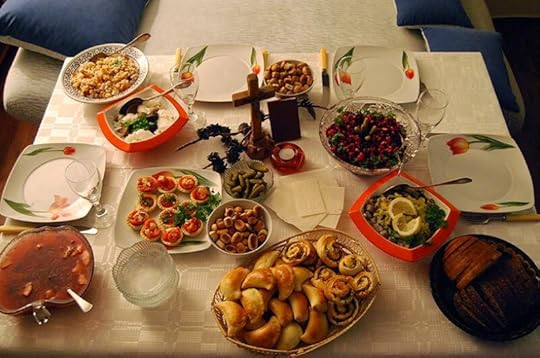Benny Lewis's Blog, page 23
December 19, 2021
Japanese Zodiac Signs: How to Talk About Zodiac and Horoscopes
Are you interested in the Japanese zodiac? Or maybe you’re curious about Japan’s love of fortune-telling?
Fortune telling is a common practice and interest in Japan. There are a lot of popular ways to receive a prediction, such as the 12 zodiac animals, blood type, horoscopes, and tarot.
There’s also 動物占い (doubutsu uranai, “animal fortune”) and 御神籤 (omikuji, fortunes written on strips of paper at shrines).
While horoscopes are pretty popular everywhere in the world, they’re one of the newer fortune-telling methods in Japan. The animal zodiac and blood types have been the two most prominent for a long time.
It’s believed that those born in the year of a zodiac animal have some of the personality traits it imbues. Some believe that blood type, zodiac, and horoscope can determine a romantic match’s compatibility. (Especially if they use a match-making service, which does still happen)
Other times, Japanese people just look to these fortunes for guidance.
Since the zodiac and blood types are often used as small talk in conversation with new acquaintances, it’s a good idea to learn about them. Even if fortune-telling isn’t your cup of tea.
Let’s take a look at different Japanese zodiac signs and more:
function runSplitTest(){var randomNumber = Math.floor(Math.random() * 2) + 1console.log(randomNumber)var copy = "";if (randomNumber == 1){ copy = '<i>A note from the Fluent in 3 Months team before we get started: You can chat away in Japanese for at least 15 minutes with the "Fluent in 3 Months" method. All it takes is 90 days. <b><a href="https://fluentin3months.com/challenge... this link to find out more.</b></a></i>'} else { copy = '<i>Before we get started, if you’re looking for an online Japanese course, here’s the course I recommend: <a href="https://www.fluentin3months.com/olly-... Uncovered - Learn Japanese Through the Power of Story</b></a>, a course with a fascinating new method by my friend Olly. You can try it for free for 7 days!</i>'}console.log(copy)var copyToChange = document.querySelector("p.copyText").innerHTML = copy;}runSplitTest();Table of contentsJapanese Zodiac SignsRatOxTigerRabbitDragonSnakeHorseSheepMonkeyRoosterDogBoarJapanese New Year Zodiac TraditionsJapanese HoroscopesAriesTaurusGeminiCancerLeoVirgoLibraScorpioSagittariusCapricornAquariusPiscesJapanese Blood TypesWhat is My Japanese Birth Year? Eras in JapanRelated Japanese Fortune-Telling VocabWhat’s Your Fortune?Japanese Zodiac SignsThe 12 signs are Japanese zodiac animals, and each of the animals represents a block of years 12 years apart.
So… Are the Japanese and Chinese zodiacs the same? Do Japanese people believe in the Chinese zodiac?
Essentially, yes. Japan adopted the zodiac from China. But there are a few small changes.
For example, in China, the calendar has a Pig. But in Japan, it’s a Boar. Also, the Chinese zodiac follows the lunar calendar system, but Japan’s is based on the solar calendar.
That just means they don’t celebrate the zodiac on the same day. The Chinese New Year is normally sometime between late January and mid-February. Japan celebrates it on New Year’s Day, or 正月 (shougatsu).
Besides the 12 animals, there are also 5 elements (called “Celestial Stems”). They are water, wood, fire, earth, and metal. They change every year along with the animal and add more dimension to the traits of the person born in that year.
“Zodiac” in Japanese is 干支 (eto), but specifically the 12 zodiac signs are called 十二支 (juunishi).
Here’s a bit about the 12 animals and the Japanese zodiac years they represent:
RatJapanese Word: ネズミ, nezumi
Zodiac Kanji: 子, ne
Years: 1912, 1924, 1936, 1948, 1960, 1972, 1984, 1996, 2008, 2020
Attributes: Ambitious, resourceful, persuasive, greedy, hot-tempered
Japanese Word: 牛, ushi
Zodiac Kanji: 丑, ushi
Years: 1913, 1925, 1937, 1949, 1961, 1973, 1985, 1997, 2009, 2021
Attributes: Patient, confident, trustworthy, stubborn, conservative
Japanese Word: 虎, tora
Zodiac Kanji: 寅, tora
Years: 1914, 1926, 1938, 1950, 1962, 1974, 1986, 1998, 2010, 2022
Attributes: Courageous, empathetic, passionate, short-tempered, selfish
Japanese Word: 兎, usagi
Zodiac Kanji: 卯, u
Years: 1915, 1927, 1939, 1951, 1963, 1975, 1987, 1999, 2011, 2023
Attributes: Popular, elegant, sincere, gullible, reserved
Japanese Word: 竜, ryuu
Zodiac Kanji: 辰, tatsu
Years: 1916, 1928, 1940, 1952, 1964, 1976, 1988, 2000, 2012, 2024
Attributes: Warm-hearted, noble, fearless, short-tempered, wild
Japanese Word: 蛇, hebi
Zodiac Kanji: 巳, mi
Years: 1917, 1929, 1941, 1953, 1965, 1977, 1989, 2001, 2013, 2025
Attributes: Clever, determined, wise, indifferent, introverted
Japanese Word: 馬, uma
Zodiac Kanji: 午, uma
Years: 1918, 1930, 1942, 1954, 1966, 1978, 1990, 2002, 2014, 2026
Attributes: Independent, energetic, charming, impatient, short-tempered
Japanese Word: 羊, hitsuji
Zodiac Kanji: 未, hitsuji
Years: 1919, 1931, 1943, 1955, 1967, 1979, 1991, 2003, 2015, 2027
Attributes: Kind, peaceful, creative, shy, indecisive
Japanese Word: 猿, saru
Zodiac Kanji: 申, saru
Years: 1920, 1932, 1944, 1956, 1968, 1980, 1992, 2004, 2016, 2028
Attributes: Clever, inventive, skillful, manipulative, erratic
Japanese Word: 鶏, niwatori
Zodiac Kanji: 酉, tori
Years: 1921, 1933, 1945, 1957, 1969, 1981, 1993, 2005, 2017, 2029
Attributes: Practical, observant, diligent, outspoken, overambitious
Japanese Word: 犬, inu
Zodiac Kanji: 戌, inu
Years: 1922, 1934, 1946, 1958, 1970, 1982, 1994, 2006, 2018, 2030
Attributes: Loyal, honest, generous, kind, stubborn
Japanese Word: 猪, inoshishi
Zodiac Kanji: 亥, i
Years: 1923, 1935, 1947, 1959, 1971, 1983, 1995, 2007, 2019, 2031
Attributes: Strong, affectionate, humble, naive, hot-tempered
While Japan doesn’t celebrate the Lunar New Year anymore, there are still zodiac traditions at the New Year.
During 正月 (shougatsu), the Japanese New Year, many people visit shrines. This visit is called 初も出 (hatsumode), or the first shrine visit of the year. People will write on wooden plaques (called 絵馬, ema) their wishes for the year and hang them at the shrine.
There’s also a tradition of getting 御神籤 (omikuji) from the shrines, which are rolled up paper fortunes. Sometimes, they’re 干支神籤 (eto-mikuji), or zodiac-themed fortunes.
These fortunes can bring you wonderful good luck and great fortune, or horrible back luck. If you get a lucky fortune, you’re supposed to keep it with you (such as in your wallet, purse, or coat pocket).
But if you get a bad fortune… You’re supposed to tie it to a branch at the shrine so you leave the bad luck behind.
At New Year’s, you’ll also find lots of New Year’s greeting cards called 年賀状 (nengajou). They’re often themed with the zodiac animal of the year and are delivered on January 1st. They’re sent to anyone you have a relationship with, such as friends, family, teachers, co-workers, and more.
Japanese HoroscopesOkay, so what about horoscopes? For example, you may be wondering, “What is the Japanese zodiac for Capricorn?”
So while the animal zodiac is one way of predicting traits and fortunes, Japan also uses astrology horoscopes as well.
The horoscopes, or astrology zodiac, are called 星座 (seiza). This also means “constellation.”
Here are the astrology signs in Japanese. Keep in mind, the dates for each zodiac sign shift slightly each year. If you don’t know yours, use a zodiac calculator to figure it out.
AriesJapanese Word: 牡羊座, ohitsujiza
Sign:  , the ram
, the ram
Date of Birth: March 20 – April 19
Element: Fire
Attributes: Passionate, bold, headstrong, impatient
Japanese Word: 牡牛座, oushiza
Sign:  , the bull
, the bull
Date of Birth: April 29 – May 20
Element: Earth
Attributes: Loyal, stubborn, ambitious, abundance
Japanese Word: 双子座, futagoza
Sign:  , the twins
, the twins
Date of Birth: May 20 – June 21
Element: Air
Attributes: Playful, expressive, intellectual, flaky
Japanese Word: 蟹座, kaniza
Sign:  , the crab
, the crab
Date of Birth: June 21 – July 22
Element: Water
Attributes: Intuitive, compassionate, sensitive, homebody
Japanese Word: 獅子座, shishiza
Sign:  , the lion
, the lion
Date of Birth: July 22 – August 22
Element: Fire
Attributes: Confident, passionate, prideful, vain
Japanese Word: 乙女座, otomeza
Sign:  , the virgin
, the virgin
Date of Birth: August 22 – September 22
Element: Earth
Attributes: Logical, diligent, judgemental, perfectionist
Japanese Word: 天秤座, tenbinza
Sign:  , the scales
, the scales
Date of Birth: September 22 – October 23
Element: Air
Attributes: Balanced, beauty, peaceful, indecisive
Japanese Word: 蠍座, sasoriza
Sign:  , the scorpion
, the scorpion
Date of Birth: October 23 – November 22
Element: Water
Attributes: Passionate, powerful, mysterious, jealous
Japanese Word: 射手座, iteza
Sign:  , the archer
, the archer
Date of Birth: November 22 – December 21
Element: Fire
Attributes: Genuine, inquisitive, irresponsible, adventurous
Japanese Word: 山羊座, yagiza
Sign:  , the sea goat
, the sea goat
Date of Birth: December 21 – January 20
Element: Earth
Attributes: Strong, leader, apathetic, inflexible
Japanese Word: 水瓶座, mizugameza
Sign:  , the water bearer
, the water bearer
Date of Birth: January 19 – February 18
Element: Air
Attributes: Free-spirited, rebellious, eccentric, aloof
Japanese Word: 魚座, Uoza
Sign:  , the fishes
, the fishes
Date of Birth: February 18 – March 20
Element: Water
Attributes: Romantic, empathetic, creative, careless
Blood types are a big deal in Japan. They’re often a topic in small talk and are used to predict personalities and fortunes. It even has a name: the “Japanese Blood Type Personality Theory.”
In fact, magazines and papers often have blood type horoscopes rather than astrology ones.
“Blood type” in Japanese is 血液型 (ketsuekigata). And in small talk, you may be asked, 血液型は何ですか? (ketsuekigata wa nan desu ka, “What’s your blood type?”)
To reply, you just say the letter + です, desu. For example, Aです。
Here’s what personality types Japanese believe each blood type has:
Type A: organized, stubborn, perfectionist, reliable, kindType AB: selfish, wild, creative, outgoingType B: eccentric, popular, trustworthy, impatientType O: optimistic, calm, easygoing, cautiousThis is seriously a Whole Thing in Japan, so if you want to learn more about its cultural impact, Tofugu wrote an excellent article about blood types.
What is My Japanese Birth Year? Eras in JapanSo the last thing you should know is that there’s also a traditional calendar marked by the reign of the emperor.
Your Japanese birth year would be called whatever year of the era you’re in.
For example, the current era is called Reiwa, for the reign of Emperor Naruhito. Before that, Emperor Akihito reigned and his era was called Heisei.
This is why you’ll hear things like “the Meiji Era” or “the Showa era” often when referring to different points in Japanese history.
So, the current era began in 2019 when Prince Naruhito became Emperor. That makes 2019 Reiwa 1. 2021 is Reiwa 3.
The Heisei era went from 1989 to 2019, so it ranged from Heisei 1 to Heisei 31.
You can see the calendar conversion here to figure out what year and what era you were born.
Related Japanese Fortune-Telling VocabBesides the zodiac, it’d be helpful to know how to talk about them and some extra vocabulary. So here’s what you need to know:
Astrology: 占星術, senseijutsuHoroscope: 星占い, hoshi uranaiConstellation: 星座, seizaThe North Star: 北極星, hokkyokuseiLittle Dipper/Ursa Minor: こぐま座, kogumazaBig Dipper/Ursa Major: おおぐま座, oogumazaSun: 太陽, taiyouMoon: 月, tsukiMercury: 水星, suiseiVenus: 金星, kinseiEarth: 地球, chikyuuMars: 火星, kaseiJupiter: 木星, mokuseiSaturn: 土星, doseiUranus: 天王星, tennouseiNeptune: 海王星, kaiouseiPluto: 冥王星, meiouseiFortune-telling: 占い, uranaiFortune-teller: 占い師, uranaishi“What’s your sign?”: 星座は何ですか, seiza wa nan desu ka or just 何座ですか, nanza desu ka“I’m a Scorpio.”: 蠍座です, sasoriza desu“What’s your Japanese zodiac sign?”: 干支は何ですか, eto wa nan desu ka“I was born in the year of the horse.”: 馬の年に生まれました, uma no toshi ni umaremashita.“Year of the rabbit.”: うさぎの年, usagi no toshiWhat’s Your Fortune?You’ve learned a lot about the Japanese zodiac and fortune-telling. Now you can practice talking about it in Japanese — what’s your sign?
Ready for your next Japanese lesson? Here are some ideas for what you can learn next:
Days of the Week in Japanese: A Simple GuideAll about Kawaii Culture in JapanJapanese Proverbs about Life, Love, and WisdomHow to Use Meditation and Netflix to Learn JapaneseThe post Japanese Zodiac Signs: How to Talk About Zodiac and Horoscopes appeared first on Fluent in 3 Months.



December 16, 2021
Traditional Christmas Food From Around the World [With Photos!]
How about we share a winter holiday trip together? No need to pack your suitcase or buy a plane ticket. Let’s have a look at traditional Christmas food from all over the globe instead!
When it comes to the winter holidays, food traditions are an important part of the celebrations in countries around the world, even if the foods are different from country to country.
(Likewise, Santa is different too, depending on where you live).
You might indulge in mince pies, or perhaps ham is more your style. For others, a holiday meal wouldn't be complete without fried chicken, fruit cake or salted cod. Depending on where you grew up, and where you live now, the seasonal delicacies that grace your table may be sweet, savory, or a little bit of everything in-between.
Let's take a look at different Christmas and Hanukkah food traditions around the world.
function runSplitTest(){var randomNumber = Math.floor(Math.random() * 2) + 1console.log(randomNumber)var copy = "";if (randomNumber == 1){ copy = '<i>A note from the Fluent in 3 Months team before we get started: You can chat away in a new language for at least 15 minutes with the "Fluent in 3 Months" method. All it takes is 90 days. <a href="https://www.fluentin3months.com/other... this link to find out more.</a></i>'} else { copy = '<i>A note from the Fluent in 3 Months team before we get started: You can chat away with a native speaker for at least 15 minutes with the "Fluent in 3 Months" method. All it takes is 90 days. <a href="https://www.fluentin3months.com/other... this link to find out more.</a></i>'}var copyToChange = document.querySelector("p.copyText").innerHTML = copy;}runSplitTest();Table of contents1. Bacalao, the Traditional Mexican Christmas Food2. The Traditional Christmas Food in Germany: Christmas Goose3. A Traditionally American Christmas Dessert: Fruitcake4. The Surprising Japanese Christmas Tradition: Fried Chicken5. Kūčios, Lithuania’s Christmas Meal6. Celebrate Hanukkah in Israel with Latkes7. Panettone, One of Italy’s Christmas Breads8. Spend Christmas in Costa Rica, Eat Traditional Tamales9. The Traditional Christmas Pudding From England10. The Famous Bûche de Noël of French Christmases11. Bulgaria’s Traditional Christmas Dish: Kolivo (коливо)12. Melomakarona (μελομακάρονα), a Sweet Greek Christmas Tradition13. More Traditional Christmas Treats: Kołaczki From Poland14. In Sweden, Christmas Comes with Saffron Buns15. Roast Pig, the Traditional Christmas Food in the Philippines16. Joulupöytä, Finland’s Traditional Christmas Food BoardWhich Food Will You Try During the Holidays This Year?1. Bacalao, the Traditional Mexican Christmas Food Traditional Mexican Christmas Food: Bacalao a la Mexicana (salted fish!
Traditional Mexican Christmas Food: Bacalao a la Mexicana (salted fish! Bacalao, or salted cod, is not common in most countries during the holidays, but it’s a staple dish in Mexico.
Before refrigeration existed, salting and preserving meats and fish was necessary. Today, this is no longer the case, but the practice still exists. And when, in the case of bacalao, the fish is rehydrated and cooked, the result is tender and delicious.
In Mexico, the ingredients to make theBacalao a la Mexicana include tomatoes, ancho chiles, onions, cinnamon, potato and olives. It’s filling and it certainly warms you up!
Make bacalao with this recipe.
Related Learning: Merry Christmas in Spanish: All the Spanish Holiday Vocab You Need for a “Feliz Navidad”
2. The Traditional Christmas Food in Germany: Christmas Goose The Traditional Christmas Food in Germany: Christmas Goose
The Traditional Christmas Food in Germany: Christmas Goose The German Christmas feast historically centres around the Weihnachtsgans, the Christmas goose.
A tradition dating back to the Middle Ages, eating goose was originally tied to St. Martin’s Day, but eventually became a part of the Christmas meal.
Often stuffed with apples, chestnuts, onions, and prunes, then spiced with mugwort and marjoram, Germans serve the goose alongside red cabbage, dumplings, gravy and sauerkraut.
The oldest known recipe for this dish comes from a cookbook published in 1350, ‘Das Buch von guter Speise’.
You can read more about German Christmas and holiday traditions here!
Want to have a German style Christmas dinner this year? Here’s a recipe for for Christmas goose.
3. A Traditionally American Christmas Dessert: Fruitcake Traditional Christmas Food in the USA: Fruitcake
Traditional Christmas Food in the USA: Fruitcake Calvin Trillin theorized that there is only one fruitcake and that it is simply sent from family to family each year. Most Americans turn their noses at the very thought of fruitcake. But for some reason, this item keeps making the rounds.
(Something made possible because the cakes are soaked in alcohol or other liquors to keep them from molding.)
Don’t believe me? On The Tonight Show, Jay Leno sampled a cake that someone had kept as a family heirloom dating back to 1878. In 2017, the Antarctic Heritage Trust found an 106-year-old fruitcake they deemed “almost edible”.
As a kid growing up, my parents always had two or three of them hidden in the pantry around Christmas. They received them as gifts and would step around them until – whoops – they were forgotten, had ‘expired’ (as much as a fruitcake can expire), and could be safely discarded without offending the other party.
So why do we eat it? Or at the very least, gift it?
At some point in history, fruitcake was a display for prosperity. Dried fruits and nuts were expensive items and so people served this cake at special events – like Christmas – to, for lack of a better way to say it, show off.
Even though fruitcakes are no longer a way to display wealth, giving them is a tradition that has just stuck.
Try this recipe for Christmas fruitcake.
4. The Surprising Japanese Christmas Tradition: Fried Chicken Traditional Japanese Christmas Food: Fried Chicken (a special KFC bucket)
Traditional Japanese Christmas Food: Fried Chicken (a special KFC bucket) In Japan, the Christmas season is the most wonderful time of the year for Kentucky Fried Chicken, or KFC, a fast food chain. Because about 3.6 million Japanese families eat KFC on Christmas Eve, they often need to reserve their meal up to two months in advance.
During the 1970s, KFC put together a holiday party bucket and behind it, a brilliant marketing plan. At the time, Japan didn’t have many Christmas traditions. KFC filled that void by telling consumers “here is something that you should do on Christmas”. The trend caught on quickly.
Today, the KFC Christmas bucket doesn’t include just fried chicken. It also includes a Christmas cake – another important food item on Japan’s holiday menu.
Here’s a good recipe for Japanese Christmas Cake.
Related Learning: “Food” in Japanese: The Ultimate Guide to Japanese Cuisine
5. Kūčios, Lithuania’s Christmas Meal Table Laid with the Traditional Christmas Meal in Lithuania: Kucios
Table Laid with the Traditional Christmas Meal in Lithuania: Kucios Kūčios, the traditional Lithuanian Christmas dinner, is held on December 24th every year. And hosting kūčios is no small feat – this meal can take up to a week to prepare.
For Lithuanians, the holidays are about spending time with family, so a week-long meal prep is certainly a great opportunity for families to get together and is likely why the tradition has persisted.
Originally kūčios had nine dishes. It was a pagan practice that later expanded to 12 dishes (one for each apostle) when it was appropriated by the Christian church.
No meat, dairy, or hot food are a part of this meal. Instead, it includes fish, breads, and vegetables. Some of the items you might see on the menu are herring served in a tomato, mushroom or onion based sauce, smoked eel, vegetables such as potatoes, sauerkraut (it’s cabbage so it counts as a vegetable, right?), and mushrooms, bread or cranberry pudding.
Try a recipe for cranberry fruit jelly and read more about it in this post covering holiday foods, decorations and greetings from around the world.
6. Celebrate Hanukkah in Israel with Latkes Latkes, the traditional fried potato pancakes for Hanukkah in Israel
Latkes, the traditional fried potato pancakes for Hanukkah in Israel Since the Middle Ages, latkes have been an important part of Hanukkah tradition. Latkes are fried potato pancakes cooked in oil. This recognizes that the Second Temple kept the Menorah burning with oil for eight days.
Other dishes enjoyed as a part of this tradition include fried donuts and fritters. Hanukkah gelt, small chocolate coins, are given to children by relatives.
Try this latke recipe.
Related Resources: Benny’s Top Resources for Learning Hebrew
7. Panettone, One of Italy’s Christmas Breads Panettone, a traditional Christmas bread in Italy
Panettone, a traditional Christmas bread in Italy Italy has numerous regional traditions when it comes to Christmas dinner.
In some parts of Italy, they celebrate with The Feast of the Seven Fishes. This meal includes seven different fish prepared in seven different ways. More often than not, two of the featured items are baccalà (salted cod) and calamari.
In other areas, they eat roasted lamb, or poultry roasted or boiled and seasoned with sauce.
Sweets also play an important role during the holiday season, and in Northern Italy, one of the infamous holiday sweets is panettone – a cake with candied fruit, chocolate, raisins, and nuts.
Other treats include torrone, nougat, marzipan, zeppole, cannoli, and pandoro.
You can read more about Italian Christmas and holiday traditions here!
Learn to make panettone with this recipe.
8. Spend Christmas in Costa Rica, Eat Traditional Tamales Photo of Tamales, a corn-based traditional Christmas dish in Costa Rica
Photo of Tamales, a corn-based traditional Christmas dish in Costa Rica In Costa Rica, making tamales is a Christmas tradition and every family has their own ‘secret’ recipe.
The basis of tamales is a corn dough, wrapped in a banana leaf or corn husk, and then steamed. Some are stuffed with pork, and some with beef or chicken. Other foods that may be a part of the filling are garlic, onion, potatoes, or raisins.
Try this recipe for tamales.
Learn some Spanish food vocab in this post!
9. The Traditional Christmas Pudding From England Photo of the traditional Christmas Pudding from England
Photo of the traditional Christmas Pudding from England This dish goes by many names. Whether you call it figgy pudding, plum pudding, ‘pud’ or Christmas pudding, this dessert is a key Christmas tradition in England, Ireland and some parts of the US.
Despite its name, plum pudding doesn’t actually include plums. Pre-Victorian era, ‘plums’ referred to what we now call raisins, and because dried fruits are an important part of this pudding, it is how it earned its name.
Primarily made of suet, egg, molasses, spices, and dried fruits, Christmas pudding is set alight with brandy immediately before it is served.
Try this classic Christmas pudding recipe.
10. The Famous Bûche de Noël of French Christmases Photo of a Bûche de Noël, a traditional Christmas yule log in France
Photo of a Bûche de Noël, a traditional Christmas yule log in France La Bûche de Noël is a dessert that symbolically represents the Yule Log – a wood log that was traditionally carried into the home, sprinkled with wine, and then burned on Christmas Eve. In the 1940s when the practice started to disappear, this dessert took up the mantle.
Often made from sponge cake and chocolate buttercream, la Bûche de Noël looks quite a bit like a real log.
Other variations of the dessert have emerged. Now you can find recipes for anything from tiramisu to cran-raspberry mascarpone, caramel cream to Meyer lemon.
You can read more about French Christmas and holiday traditions here!
Try this recipe for la Bûche de Noël.
11. Bulgaria’s Traditional Christmas Dish: Kolivo (коливо) Photo of Kolivo, a traditional Christmas dish in Bulgaria
Photo of Kolivo, a traditional Christmas dish in Bulgaria Kolivo, boiled wheat with sugar and walnuts, is often the first item to appear on tables come Christmas Eve in Bulgaria. Similar to a pudding, both Russia (кутья) and Poland (kutia) have comparable dishes.
Sometimes served with honey, poppyseed, other grains, rice, beans, or dried fruit, kolivo can be prepared in many different ways. It is often connected with Orthodox traditions. In addition to Bulgaria, it also appears on tables in Serbia, Romania, Georgia, and Ukraine.
Try this recipe for kolivo.
12. Melomakarona (μελομακάρονα), a Sweet Greek Christmas Tradition Photo of Melomakarona, traditional Greek Christmas treats
Photo of Melomakarona, traditional Greek Christmas treats Sweet orange-zest cookies soaked in honey and topped with walnuts? Yes, please!
This item is a holiday treat that regularly appears on tables in Greece. Known as melomakarona, these cookies are often said to taste much like baklava.
Immediately after they’re baked, melomakarona are soaked in a honey-sugar water mixture then sprinkled with walnuts. There is also a less traditional version of this recipe dipped in dark chocolate.
Either way – sign me up.
Try this recipe for melomakarona.
Related Learning: Learn Greek Online: 39 Free Resources and Classes to Learn the Greek Language
13. More Traditional Christmas Treats: Kołaczki From Poland A plate of Kołaczki, the Traditional Polish cookies for Christmas
A plate of Kołaczki, the Traditional Polish cookies for Christmas Another country with cookies on the menu come holiday season is Poland. Kołaczki is a flaky, jelly-filled confection, with dough often made with sour cream or cream cheese.
These fold-over style cookies come with a variety of fillings. If the standard apricot or raspberry doesn’t do it for you, you can also try poppyseed, nuts, or sweet cheese. They’re topped with confectioners sugar immediately before serving.
Try this recipe for Kołaczki.
Try another traditional Polish recipe for cheese and potato pierogi.
Related Learning: Start Learning Polish – The Easy Way
14. In Sweden, Christmas Comes with Saffron Buns A plate of traditional Christmas Saffron Buns form Sweden
A plate of traditional Christmas Saffron Buns form Sweden Julbord, a three course meal, is served come Christmas in Sweden. The first dish is usually fish – often pickled herring. Second, cold cuts (including Christmas ham) along with sausages are served. The third course is often meatballs and a potato casserole called Janssons frestelse.
For dessert, rice pudding is popular, but there’s another treat for which the Swedes are known to make around this time – saffron buns.
Saffron buns are sweet and often yellow in color (due to the saffron, of course!). They are shaped into an “S” and then baked into their final buttery form.
They’re served to the family by the oldest daughter, by tradition, but that shouldn’t stop you from trying your hand at making them, and most importantly, enjoying the end product.
Make Swedish saffron buns.
Related Learning: How to Learn Swedish: 37 Lessons from My 6 Months Living in Sweden
15. Roast Pig, the Traditional Christmas Food in the Philippines An entire Roast Pig, traditional Christmas dish in the Philippines
An entire Roast Pig, traditional Christmas dish in the Philippines Noche Buena, Christmas dinner in the Philippines, takes place after families attend the Misa de Gallo (“Mass of the Rooster”). Hamón (cured pork leg) or Lechón (spit-roasted pig) are the main features. Their co-stars are often queso de bola (a ball of cheese), pasta, lumpia (spring rolls) and fruit salad.
Christmas is a big deal in the Philippines. Christmas carols start as early as September and end usually around January 9th, with the feast of the Black Nazarene. Official observance, however, is from December 16th until the first Sunday of the new year.
Make Filipino-style pineapple-glazed ham.
Related Learning: Benny’s Top Resources for Learning Tagalog
16. Joulupöytä, Finland’s Traditional Christmas Food Board Joulupöytä, Finland’s Traditional Christmas Food Board
Joulupöytä, Finland’s Traditional Christmas Food Board Fins go buffet style, or literally “Christmas table” style, for their Christmas meal with Joulupöytä. This traditional food board is comparable to the Swedish smörgåsbord or julbord. It contains several dishes typical of the season such as Christmas ham, fish, and casseroles.
Other items on the table may include mushroom salad, pickled herring, and Karelian stew. For dessert, joulutorttu (tarts), piparkakku (Gingerbread), and rice pudding are served.
Bake joulutorttu for Christmas.
Which Food Will You Try During the Holidays This Year?Food traditions certainly abound across the globe come the holidays. No matter what you eat during this time of year, we wish you all:
Bon appétit, buen provecho, いただきます, kalon digor, 慢慢吃, dobar tek!
The post Traditional Christmas Food From Around the World [With Photos!] appeared first on Fluent in 3 Months.



December 13, 2021
“Merry Christmas” in German – Vocab and Traditions of a “Frohe Weihnachten”!
Have you ever wondered how to say “Merry Christmas” in German? Do you have German-speaking friends you’d like to send happy wishes to? Or are you a curious German student?
Look no further – in this article, I’ll teach you how to say “Merry Christmas” in German and give you a variety of ways to wish someone happy holidays.
Bonus? I’ll tell you funny anecdotes about German winter holiday traditions.
function runSplitTest(){var randomNumber = Math.floor(Math.random() * 2) + 1console.log(randomNumber)var copy = "";if (randomNumber == 1){ copy = '<i>A note from the Fluent in 3 Months team before we get started: You can chat away in German for at least 15 minutes with the "Fluent in 3 Months" method. All it takes is 90 days. <b><a href="https://fluentin3months.com/challenge... this link to find out more.</b></a></i>'} else { copy = '<i>Before we get started, if you’re looking for an online German course, here’s the course I recommend: <a href="https://www.fluentin3months.com/olly-... Uncovered - Learn German Through the Power of Story</b></a>, a course with a fascinating new method by my friend Olly. You can try it for free for 7 days!</i>'}console.log(copy)var copyToChange = document.querySelector("p.copyText").innerHTML = copy;}runSplitTest();Table of contentsHow to Wish a Merry, Merry German ChristmasWeihnachten – What Does the German Word for Christmas Literally Mean?Other Ways to Wish a Merry Christmas and a Happy New Year in GermanVocab Recap: German Christmas VocabularyWishing a Happy New Year in GermanVocab Recap: German New Year Wishes VocabularyCelebrating New Year’s Eve in the German WorldVisiting a Traditional Christmas MarketCelebrating Christmas With German FriendsConclusionHow to Wish a Merry, Merry German ChristmasTwo of the most common ways to wish someone a Merry Christmas in German are as follows:
Frohe Weihnachten!Fröhliche Weihnachten!But what do frohe and fröhliche mean, you may ask? While these two forms are similar in meaning, frohe is a bit more formal and somewhat less playful than fröhliche.
Fröhlich literally means “filled with joy,” “carefree happy,” “enjoyable” or “that brings joy.” It is an adjective related to froh, to which we add -e to agree with the neuter Weihnachten.
As my German friend says, “Why wish someone a frohe Weihnachten when, for just one syllable more, you can wish them a fröhliche Weihnachten?” This is to say that the fröhlich greeting is a bit more intimate and friendly – but you are free to choose whichever of the two you wish!
Weihnachten – What Does the German Word for Christmas Literally Mean?The German word for Christmas, Weihnachten, comes from the Middle High German ze den wihen nahten, which means “in the consecrated, holy nights.”
If you pull the word apart, you can see two parts: Weih and Nacht. Whereas Weih gives the word its “consecrated, holy” meaning, Nacht is the German word for night.
Most commonly, Weihnachten is treated grammatically as a neuter single noun, usually without an article and often with the preposition zu:
Was willst du zu Weihnachten von mir? – “What do you want from me for Christmas?”In some German-speaking places, notably parts of Switzerland and Austria, Weihnachten is treated as a plural noun:
Ich werde diese Weihnachten im Ausland verbringen. – “I’ll spend Christmas abroad.”If all this talk of articles and grammar is getting you in a Bah Humbug mood, check out this article on German articles!
Other Ways to Wish a Merry Christmas and a Happy New Year in GermanIf you’re looking for other ways to wish someone happy holidays in German, just wait – there’s more!
We all know that language is a tool that we can manipulate to meet different needs. Even in this specific context, we can wish someone a happy holiday in a lot of different ways: we can be formal, we can be secular, or we can be super jolly!
If you want to wish a German a happy holiday season in a less directly religious way, you can use one of these:
Schöne Feiertage! Happy holidays! Frohe Festtage! Happy holidays! Frohe Feiertage! Happy holidays!If you’d like to make a sentence, you can try this one:
Ich wünsche dir ein frohes Fest! – “I wish you happy holidays!”Vocab Recap: German Christmas Vocabulary das Weihnachten Christmas Frohe/Fröhliche Weihnachten! Merry Christmas! Schöne Feiertage! Happy holidays! Frohe Festtage! Happy holidays! Frohe Feiertage! Happy holidays! Ich wünsche dir ein frohes Fest! I wish you a happy holiday! Wishing a Happy New Year in GermanWhen we talk about Christmastime, we often say “the holiday season” because the holiday often extends into New Year’s. People tend to group these days together as a time when people take time off from work and come together to meet with family and friends.
So sometimes, when we wish someone a Merry Christmas or happy holidays, we include a New Year’s greeting too. Here are some ways to wish someone a happy new year in German:
Alles Gute zum neuen Jahr! All well for the new year! Einen guten Rutsch ins neue Jahr! A good start to the new year! Prosit Neujahr! Happy new year! Gesundheit, Glück und Erfolg! Health, luck, and success! Ein glückliches neues Jahr! Happy new year!Guten Rutsch is a very common New Year’s greeting in German, and it’s worth a closer look. Although the word Rutsch may look similar to the verb rutschen, which means “to slide,” it apparently does not come from this verb.
The exact origins of the phrase are, however, a bit controversial. Some linguists point to the Yiddish Rosch, coming from the Jewish festival Rosh Hashanah. Others believe it originates from the Old German Rutsch, which used to mean “journey.”
Vocab Recap: German New Year Wishes Vocabulary Alles Gute zum neuen Jahr! Best wishes for the new year! Einen guten Rutsch ins neue Jahr! (I wish you) a good start to the new year! Prosit Neujahr! Happy new year! Gesundheit, Glück und Erfolg! Health, luck, and success (for the new year)! Ein glückliches neues Jahr! A happy new year! Celebrating New Year’s Eve in the German WorldInterestingly enough, New Year’s Eve is called Silvester in German. The origin of the name is due to Pope Silvester the 1st, who died on December 31st, 335.
When I arrived in Berlin sometime in the afternoon of January 1st, 2021, what I noticed most on the streets were the remains of firecrackers and posters announcing Silvester parties that took place while I was still in the air.
Talk about a visual way to memorize vocabulary!
If you end up celebrating Silvester with a German friend, you may end up finding some weird things in your wallet: some people believe that certain items, like ladybugs, four-leaf clovers, or special mushrooms in your Portemonnaie bring good luck for the new year!
Or you may eat a buffet, perhaps including some Swiss fondue to await the arrival of the new year, the neues Jahr. You may drink a sort of fruit punch, or a Bowle, with or without alcohol, or a simple elegant sparkling wine, Sekt in German. Perhaps you’ll set off some Böller that will light up the sky and, according to customs dating back to older Germanic tribes, scare the ghosts up above.
der Silvester New Year’s Eve das Portemonnaie wallet die Bowle (“w” here is not pronounced according to normal German pronunciation rules, where “w” sounds like an English “v”; since it is an English loanword, the “w” has approximately the same pronunciation as it does in English.) Fruit punch often served at New Year’s parties der Sekt Sparkling wine der Böller Firework Visiting a Traditional Christmas MarketThe German-speaking world is known for its charming Christmas markets, or Weihnachtsmärkte. While cities all over Germany, Switzerland, and Austria host their own markets, Nuremberg’s is one of the most famous. Said to be originating from 1628, it’s one of the oldest in Germany!
Although perhaps not quite as famous, Salzburg’s Christkindlmarktis also well worth the visit! It is rumored that the first “Holy Night, Silent Night” (Stille Nacht, Heilige Nacht in German) was sung there in 1818.
Now imagine you’re in Nuremberg, surrounded by Christmas spirit – you may first grab a Glühwein, a special Christmas mulled wine, to warm yourself up in the cold. You can smell the fresh cinnamon and nuts coming from German Christmas delicacies, such as Lebkuchen (“gingerbread”) or Weihnachtsplätzchen, Christmas cookies decorated in all sorts of ways.
You stroll leisurely, admiring the stalls with their handmade soaps, sweaters and mittens, or maybe some wooden toys, Spielzeuge in the local language!
You may also see an interesting small wooden craft in the shape of a small man, pipe in hand, real smoke coming out of his wooden mouth: this is a Räuchermännchen, a little smoking man, another classic German Christmas decoration.
And you won’t believe what’s in the Feuerzangenbowle!
If you look and see someone with a big vat of red wine, pouring rum over a sugar cone then lighting it on fire, you may want to go over and try a cup of Feuerzangenbowle, or fire tong punch; but be careful, it‘s a bit potent, so you may want to stick to one cup!
(Check out this video to see what it looks like – it’s quite a spectacle!)
All above and around you, you’re surrounded by traditional Weihnachtsschmuck, Christmas decorations; the lighting above and the stalls themselves all show a jolly, fröhliche atmosphere.
der Weihnachtsmarkt Christmas market der Glühwein Mulled wine der Lebkuchen gingerbread das Weihnachtsplätzchen Christmas cookie der Spielzeug Toy das Räuchermännchen Little smoking man (common Christmas decoration) der Weihnachtsschmuck Christmas decoration Celebrating Christmas With German FriendsDuring your visit to Germany, you might make some local friends who want to introduce you to their Christmas traditions. You might see an Adventskalender in their home, a calendar for which each day you open a little box to reveal a small picture, a little poem, or even a piece of chocolate to count down the days until Christmas.
They may encourage you to sing a Weihnachtslied with them, a Christmas song. Maybe you’ll be accompanying them to Stille Nacht, Heilige Nacht like I mentioned above, or perhaps you’ll be treated to a rendition of der kleine Trommler, Little Drummer Boy in English.
Baby es regnet doch, a German rendition of “Baby, it’s Cold Outside” (literally translated as “baby it’s raining though”) seems for some reason to be a little less Christmas-y in the German-speaking world.
You may see an Adventskranz on the wall, a special Christmas wreath typically with four candles. If you’re lucky, your hosts may ask you to help light one of the Kerzen, as Germans do on each Sunday in December to count down the weeks until the big day! Their wreath may be accompanied by a Nussknacker, or a nutcracker, another typical Christmas decoration.
And if you’re extra fortunate, you’ll be greeted on Christmas day with a weißes Weihnachten, a white Christmas with snow! You might announce to your friends, Es schneit, it’s snowing! After you bundle up with a jacket, a scarf, and a hat, you may go out to build a nice Schneemann or play with some Schneeflocke, snowflakes!
der Adventskalender Advent calendar das Weihnachtslied Christmas song Stille Nacht, heilige Nacht Silent night, holy night Der kleine Trommler Little drummer boy der Adventskranz Advent wreath die Kerze candle der Nussknacker nutcracker Es schneit. It’s snowing. der Schneemann snowman die Schneeflocke snowflake ConclusionI hope that a bit of German Christmas magic will make your holiday season a bit more special this year.
If one day you want to experience the Christmas spirit in Deutschland or another German-speaking country, get your language skills up to par with this language learning method.
And if your New Year’s resolution turns out to be to improve your Deutsch, check out [these ten hacks] (https://www.fluentin3months.com/langu...) to get on the fast track to fluency!
Frohe Festtage!
Christmas Traditions from Around the WorldGerman Uncovered Review — Honest, In-Depth Review on “StoryLearning” German [With Video]German Numbers: Learn To Count From 0 to 1,000 in GermanGerman Dialects: A Beginner’s Guide [With Videos]How to Speak German: The Faster Way to Learn GermanThe post “Merry Christmas” in German – Vocab and Traditions of a “Frohe Weihnachten”! appeared first on Fluent in 3 Months.



December 10, 2021
How to Relearn a Language from High School You Think You Forgot
As an English and Spanish teacher, I’ve heard many adult language learners say they wish they had paid more attention to the languages they studied in high school.
Growing up in the United States, mandatory language classes were a typical part of the “American high school” experience. For some of us, we were required to devote a year to mastering French grammar drills. For others, it was four semesters of Spanish verb conjugations and trying to understand the difference between tú and usted.
You had to take these classes in order to get your diploma, so you enrolled, completed assignments and passed. But then life got busy, and you had other classes to take. You wish you could have taken more, but time got in the way.
Or maybe you dreaded your language class and were thankful to close your textbook for good.
Regardless of your situation, you’re ready to revisit the language you studied in high school. And if you’re worried you forgot it, you’re not alone. This is a common fear that many adult language learners have.
However, I’m here to tell you it shouldn’t make you worry as much as you might think. Here’s why.
Table of contentsIs It Possible to Relearn a Language?How Difficult Is It to Relearn a Language?How to Relearn a Language You Think You Forgot1. Identify Your “Why”2. Remember What You Liked and Didn’t Like About the Language – And Then Forget It3. Set a Realistic Schedule You Can Stick To4. Find Resources That Resonate Best With You5. Connect with the CultureIs It Possible to Relearn a Language?Absolutely. No matter how old you are or how long it’s been since you last picked up a vocabulary flashcard, it’s possible to relearn a language you studied before.
You probably won’t start at the same level you were before you stopped taking classes, but you might be surprised at how much you remember.
While the old “use it or lose it” saying is true to some degree, you probably didn’t forget as much of the language as you think. In fact, some parts of the language will probably still be familiar to you, like:
The alphabet (if it was different from the one you use in your native language)Basic verb conjugationEveryday vocabularyPronunciation patternsOnce you start reviewing, it’s likely you’ll start remembering even more of what you studied before. That way, you’ll be able to make quick progress in the beginning.
How Difficult Is It to Relearn a Language?Choosing to relearn a language is a big commitment. However, as with anything in life, whether or not your studies are difficult depends on your mindset, experience, preparation and expectations.
Positivity is contagious, even within your own thoughts. If you start relearning a language thinking it will be impossible, you’ll likely have a harder time enjoying your studies than if you went in with a different mindset.
This can be a difficult shift to make, especially if you had a negative experience with the language before. However, it’s worth the effort to examine your thoughts before you begin your studies. That way, you know your perspective and can adjust before you begin.
In my experience, though, the most important part of relearning a language is managing your expectations for yourself.
If you struggle with imposter syndrome, you might worry that you aren’t smart enough to study the language. You might also worry that you’ll never be able to master the language because you didn’t before.
These are lies.
It’s also important to remember that there is no “should” when it comes to relearning a language.
For example, when I’m studying a language, I’ll often find myself saying, “I should be farther along than this. I should know more by now.” This thought is likely to pop up when you’re relearning a language, especially if you start thinking about how much you would know if you hadn’t stopped studying in school.
My advice? Don’t even go there. There’s no use thinking about what could have happened. All you can do now is start where you are and grow from here.
How to Relearn a Language You Think You ForgotNow that you’re in the right mindset, it’s time to look at specific steps you can take to relearn a language you think you forgot. I recommend you follow these steps before you restart your studies.
However, if you’ve already begun relearning a language, these tips are still valuable and can positively impact your study experience the second time around.
1. Identify Your “Why”When I was in high school, I took four years of Spanish. I had taken a year of Spanish in middle school because it was the only language we could study, and I continued in high school because I didn’t want to start something new.
I took a year off in college before returning to the language – and eventually majoring in it, along with Italian. While I started studying Spanish because it was my only option, I eventually returned to it as an adult because I’d found my own personal reasons for pursuing the language.
In other words, I’d found my “why.”
I love to travel and learn about countries around the world, so studying Spanish became a way for me to connect with cultures and communities in Latin America. Because I spoke Spanish, I was able to study anthropology in Argentina, explore Mayan ruins in Mexico and travel by myself in Colombia.
Because I knew I wanted to have these experiences abroad, learning how to speak Spanish fluently was a priority for me.
Your “why” might look similar, or it might be completely different. Perhaps you’re revisiting German because you found out your ancestors come from Bavaria, and you want to connect with family there. Or maybe your job does business in Milan, and you need to speak Italian at work now.
Whatever your reason, it’s important that you can identify why you want to relearn the language in school. Being clear about your purpose will help you stay focused on the days when you don’t feel like studying anymore because you’re working toward a defined goal.
2. Remember What You Liked and Didn’t Like About the Language – And Then Forget ItUnfortunately, most of the people I know who stopped studying a language after high school did so because they didn’t like it. Usually, this has more to do with how the language was taught than it does with the language itself, though.
For example, maybe when you think of your sophomore language class, you remember spending hours filling out verb charts. This repetitive activity might have felt like a waste of time for you, and it influenced how you feel about French today.
On the other hand, you might remember specific aspects about the language that you enjoyed. For instance, maybe you loved learning about:
Regional dialectsGrammar rulesSlang wordsIn either case, it’s important that you recognize what you did and didn’t like about your high school language experience.
Then, you can forget it.
Why? Because you’re not the same person anymore.
We can all think of things we hated as teenagers that we love now as adults. Our taste and opinions change as we get older, and our perspectives about languages are no different.
Regardless of how your relationship was with your target language in high school, it’s important that you recognize that you’re a different person now. Give yourself the opportunity to form a new relationship with the language.
You just might be surprised at how different your experience is this time around.
3. Set a Realistic Schedule You Can Stick ToOne of the benefits of being an adult is that you probably have more control over your schedule than you did in high school.
As an adult language learner, you can use this new flexibility to your benefit. However, if you don’t plan in advance, you might forget to schedule it in your studies.
This is a problem I see often with my language students, especially if they plan to do the majority of their learning independently.
In high school, your language classes were scheduled for you. If you’re like me, they were probably built into your schedule an hour every day, Monday through Friday. Unless you enroll in an adult language class, this benefit won’t be available to you.
As a result, you’ll be responsible for creating a schedule you can realistically commit to.
In the beginning, it’s easy to set ambitious goals. That’s because our enthusiasm for the language is fresh, and we’re excited about getting started.
However, time passes, and our enthusiasm fades. Our schedules fill up with work and family commitments. Before you know it, a week or a month has passed, and you haven’t spoken a word of the language.
Fortunately, you can avoid this pitfall before you begin. The easiest way to do this is to set a language schedule you can commit to. While it’s best to study the language every day, set a routine that works best for you.
For example, if you know you work best in the morning, set aside 20 or 30 minutes before work where you can review grammar or vocabulary. If you’re most productive at night, be ready to come home after work and have a language conversation with a partner online.
If you can’t commit to every day, that’s okay, too. Just find a routine that works for your schedule and make sure you commit to it.
4. Find Resources That Resonate Best With YouJust like you didn’t have control over your language schedule in high school, you probably didn’t have a say in the study materials you used either. Often, these resources are chosen by the school or district you’re studying in. In other instances, the teacher might be able to choose the materials you use.
As an adult language learner, the decision is yours. This means you can choose resources that you like best.
For example, if you love reading, you can spend your time enjoying novels written in your target language. If you’re a music fan, you can spend time every day translating song lyrics and enjoying different musical genres.
If you prefer more traditional study materials, you can also use your learning style as a way to help you choose the resources you’ll use. If you’re a visual learner, you might benefit best from online videos that explain grammar points or vocabulary. If you’re an auditory learner, podcasts might be your best bet. They’re also a great way to improve your listening skills.
There’s no wrong way to study. Instead, by taking the time to assess your learning style and choose materials in advance, you can avoid wasting time as you try to find tools that work best for you.
5. Connect with the CultureDepending on your high school, you may or may not have had opportunities to explore the culture connected with the language you studied. As an adult learner, I recommend you learn about the culture and language together.
By learning about culture, you can more effectively study your target language in context.
Because I know about Argentine history, for example, I understand why you’re more likely to hear vos in Buenos Aires than tú.
One of my favorite ways to learn about culture is to travel abroad and experience it for myself. However, it’s not the only way. If you can’t travel to another country right now, you can easily learn about a culture where your target language is spoken by:
Visiting a restaurant in your community that serves food related to your target language.Watch movies or read books that were originally produced in your target language.Enjoy videos online from people who live in a country where your target language is spoken.All of these are excellent ways to help you enjoy your target language in context.
Choosing to relearn a language you learned in high school can be a fun, fulfilling experience. With a little preparation in advance, you can help ensure your studies are even more successful a second time around.
#062 | Relearn a Language with Marissa BlaszkoYour First Month Learning French: A Step-by-Step GuideTeach Me German: A Step-by-Step Guide to Your First Month Learning GermanHow Adults Learn: 6 Important Things to KnowIs fluency in 3 months possible?The post How to Relearn a Language from High School You Think You Forgot appeared first on Fluent in 3 Months.



December 5, 2021
Japanese Verb Conjugation: A Beginner’s Guide [With Charts!]
Japanese verb conjugation can seem super intimidating to anyone beginning to learn Japanese.
After all, Japanese is one of the hardest languages for English speakers to learn. And a large part of that is due to how different the grammar patterns are.
But, in many ways, Japanese is easier to learn than you think.
Is Japanese conjugation easy? Well, it’s a bit tricky at first.
function runSplitTest(){var randomNumber = Math.floor(Math.random() * 2) + 1console.log(randomNumber)var copy = "";if (randomNumber == 1){ copy = '<i>A note from the Fluent in 3 Months team before we get started: You can chat away in Japanese for at least 15 minutes with the "Fluent in 3 Months" method. All it takes is 90 days. <b><a href="https://fluentin3months.com/challenge... this link to find out more.</b></a></i>'} else { copy = '<i>Before we get started, if you’re looking for an online Japanese course, here’s the course I recommend: <a href="https://www.fluentin3months.com/olly-... Uncovered - Learn Japanese Through the Power of Story</b></a>, a course with a fascinating new method by my friend Olly. You can try it for free for 7 days!</i>'}console.log(copy)var copyToChange = document.querySelector("p.copyText").innerHTML = copy;}runSplitTest();Table of contentsWhat to Know About Japanese Verb Conjugation Before You Get StartedHow Many Japanese Verb Conjugations Are There?How to Conjugate Japanese Verbs for BeginnersGodan Verbs / U-VerbsIchidan Verbs / Ru-VerbsIrregular VerbsJapanese Verb Conjugation: Present Tense, Masu-Form and Plain FormPast Tense: Formal Mashita-Form and Plain Ta-FormForming Negative Verbs in Japanese: Masen, Masen Deshita, Nai, and NakattaTe-Form in JapaneseJapanese Verb Conjugation Practice — Try It Out!Japanese Verb Conjugation Basics: Mastered!What to Know About Japanese Verb Conjugation Before You Get StartedThe positive is, grammar in Japanese is very consistent.
For example, in English, we say “I eat, I ate, I have eaten” and the verb “eat” changes with each form. For English learners, this is tricky and requires a lot of individual word memorization.
Japanese doesn’t have that problem. You have the stem of the verb, and you change the ending based on your meaning. That’s it!
There are only two irregular verbs in Japanese, and they’re so common (and even their conjugation is consistent), that they’re easy to learn.
So, once you master the basics of Japanese conjugation, the rest becomes much easier.
Many grammar patterns have similar rules once you know the present, past, negative, and continuous form in formal and informal Japanese. So learning those 4 conjugations now will save you a ton of headaches later.
By the way, if you haven’t learned how to write in Japanese yet, check out this explainer article to get started. Understanding how to write in Japanese will help you immensely with conjugating Japanese verbs.
You can also check out this guide to Japanese grammar and Japanese particles for more about Japanese sentence structure!
How Many Japanese Verb Conjugations Are There?Let's start with this big question: How many Japanese conjugations are there anyway?
Well, it depends on how you’re counting them. Verbs change by taking the stem of the verb and changing the ending. And theoretically, you could add an endless amount of things to the end of verbs.
But there are about 10 – 14 base verb conjugations, and about 150 ways to conjugate the verbs from there.
Many of those ways to conjugate are easy once you learn the base forms. So don’t worry about that large number. Focus on the base conjugations first.
In fact, we’re going to cover quite a few of them now.
How to Conjugate Japanese Verbs for BeginnersBefore we get to the actual conjugations, we need to understand how Japanese categorizes verbs.
There are 3 Japanese verb groups. They are:
Godan verbs (五段動詞, godan-doushi), also called U-verbs or V1 verbsIchidan verbs (一段動詞, ichidan-doushi), also called Ru-verbs or V2 verbsIrregular verbs (不規則動詞, fukisoku-doushi), also called V3 verbsLet’s discuss each group.
Godan Verbs / U-VerbsGodan verbs, or u-verbs, are verbs that end with the う-row of the hiragana syllabary chart.
Examples of godan verbs are:
話す (hanasu), “to speak”飲む (nomu), “to drink”死ぬ (shinu), “to die”聞く (kiku), “to hear”遊ぶ (asobu), “to play”買う (kau), “to buy”待つ (matsu), “to wait”As you can see, the u-verbs can shift through all the う-rows of the hiragana chart. And when they conjugate, the “u” can shift into the other vowel rows to change its meaning (you’ll see how in a moment!). That’s why they’re called godan verbs, which mean “five level verbs.”
Ichidan Verbs / Ru-VerbsIchidan verbs, or ru-verbs, all end in る. And because of that, they conjugate much easier than godan verbs.
Ichidan verb stems remain the same no matter what ending you attach to them, so the stem always stays in one vowel row. That’s why they’re called ichidan verbs, which mean “one level verbs.”
Examples of ichidan verbs:
食べる (taberu), “to eat”見る (miru), “to see”出る (deru), “to leave”寝る (neru), “to sleep”起きる (okiru), “to get up/wake up”調べる (shiraberu), “to investigate”Now, there’s one sticky part… Sometimes, godan (u) verbs can end in る, too.
Thankfully, there are a few tricks to telling which is which.
Ichidan verbs always end in “iru” or “eru”. Take a look at the list above. They all end in -eru or -iru.
If it ends in a, o, or u + る, then it’s a godan verb.
Even still, there are some godan verbs that end in -iru or -eru. Here are some common ones:
走る (hashiru), “to run”帰る (kaeru), “to return home”要る (iru), “to need”切る (kiru), “to cut”知る (shiru), “to know”入る (hairu), “to enter”喋る (shaberu), “to chat”Irregular VerbsLuckily, as I already mentioned, there are only two irregular verbs. And they’re so common, you’ll master them in no time.
The two irregular verbs are:
する, suru来る, kuruNow, I should note, there are regular verbs and honorific verbs that sometimes conjugate irregularly. But these verbs are not counted in the V3 group because the specific conjugation pattern is irregular, not the verb itself.
Japanese Verb Conjugation: Present Tense, Masu-Form and Plain FormOkay, okay. We’ve learned all about the verb categories. Now… How do you conjugate present tense verbs in Japanese?
Well, there are two ways: the formal masu-form, and the casual plain form.
The masu-form is the polite form of Japanese. You’ll use it when speaking to strangers, co-workers, people of higher status, and any time you need to show respect and politeness.
Let’s look at how to conjugate the different verb categories into masu-form verbs.
Present Polite Form
Verb Type Rule Example: Hiragana Romanized る-verbs Drop る and add ~ます 食べる → 食べます taberu → tabemasu う-verbs Change う to い-row and add ~ます 飲む → 飲みます nomu → nomimasu Irregular verbs する → します suru → shimasu 来る → 来ます kuru → kimasuPretty simple!
Now when we drop the final る or う, we are left with the verb stem. This is important. The verb stem is what you’ll add on to for each Japanese conjugation going forward.
So, for 食べる (taberu), the verb stem is tabe. For 飲む (nomu), it’s nom, where the final u changes vowel to conjugate. In the case of masu-form, it changes to i — nomimasu.
As for the irregular verbs, there’s no rule, but there are only two of them. Their verb stems then become shi and k (yes, just k — sometimes it’s ki and sometimes it’s ko).
Now let’s look at plain form.
You’ll use plain form when you’re speaking with family or friends, people at the same level or younger than you, and anytime you’re in a casual situation.
Present tense plain form is actually quite nice because it’s exactly what the word is in the dictionary. In fact, it’s other name is dictionary form for this reason.
So, there’s no conjugation needed. Plain present tense of 食べる is just 食べる, and so forth. So when you learn a verb in its unconjugated form, you’ve learned plain form!
Fun fact: There’s no future tense in Japanese. That’s right. Present tense is used to express the future as well, and it’s understood by context. Usually, the sentence will include words like 明日 (ashita), “tomorrow”, or 後で (ato de), “later”, to signify the future.
Past Tense: Formal Mashita-Form and Plain Ta-FormLearning past tense in polite mashita-form is easy. It’s exactly the same as masu-form, except you’ve changed the ending to ~ました, mashita, to mean the past.
Here’s the Japanese verb conjugation chart for past tense:
Past Polite Form
Verb Type Rule Example: Hiragana Romanized る-verbs Drop る and add ~ました 食べる → 食べました taberu → tabemashita う-verbs Change う to い-row and add ~ました 飲む → 飲みました nomu → nomimashita Irregular verbs する → しました suru → shimashita 来る → 来ました kuru → kimashitaSimple.
As for ta-form, that’s the plain past tense verb conjugation. る-verbs and irregular verbs are easy enough. But う-verbs are where you’re going to have to memorize some extra rules depending on which consonant comes before the final う.
Take a look:
Past Plain Form
Verb Type Rule Example: Hiragana Romanized る-verbs Drop る and add ~た 食べる → 食べた taberu → tabeta う-verbs Ends in う, つ, or る: Drop final う / つ / る and add ~った 買う → 買った kau → katta Ends in く: Drop く and add ~いた 聞く → 聞いた kiku → kiita Ends in ぐ: Drop ぐ and add ~いだ 泳ぐ → 泳いだ oyogu → oyoida Ends in す: Drop す and add ~した 話す → 話した hanasu → hanashita Ends in ぬ, ぶ, or む: Drop ぬ / ぶ / む and add ~んだ 飲む → 飲んだ nomu → nonda Irregular verbs する → した suru → shita 来る → 来た kuru → kitaAs you can see, you conjugate う-verbs depending on the final hiragana character. This can make conjugating these verbs a bit trickier to memorize, but with practice, it does become natural!
There are a handful of verbs that do not conjugate -ta and -te form (discussed below) exactly this way. One of the most notable (and common) is 行く (iku, “to go”).
行く, iku → 行った, itta (not iita)Forming Negative Verbs in Japanese: Masen, Masen Deshita, Nai, and NakattaYou’ve learned present and past positive forms. Now it’s time to learn present and past negative forms!
Let’s start with masu-form. It’s pretty simple again: just add -masen (present negative) or -masen deshita (past negative) to the verb stem.
Present Negative Polite Form
Verb Type Rule Example: Hiragana Romanized る-verbs Drop る and add ~ません 食べる → 食べません taberu → tabemasen う-verbs Change う to い-row and add ~ません 飲む → 飲みません nomu → nomimasen Irregular verbs する → しません suru → shimasen 来る → 来ません kuru → kimasenPast Negative Polite Form
Verb Type Rule Example: Hiragana Romanized る-verbs Drop る and add ~ませんでした 食べる → 食べませんでした taberu → tabemasen deshita う-verbs Change う to い-row and add ~ませんでした 飲む → 飲みませんでした nomu → nomimasen deshita Irregular verbs する → しませんでした suru → shimasen deshita 来る → 来ませんでした kuru → kimasen deshitaKeep in mind, to make the past negative form, you have the main verb in negative form and the helping verb です (desu, “to be”) in the past tense.
Now let’s look at nai and nakatta, the present and past negative forms in plain speech.
Present Negative Plain Form
Verb Type Rule Example: Hiragana Romanized る-verbs Drop る and add ~ない 食べる → 食べない taberu → tabenai う-verbs Change う to あ-row and add ~ない 飲む → 飲まない nomu → nomanai Verbs ending in う: Change う to わ and add ~ない買う → 買わない kau → kawanai Irregular verbs する → しない suru → shinai 来る → 来ない kuru → konai
Past Negative Plain Form
Verb Type Rule Example: Hiragana Romanized る-verbs Drop る and add ~なかった 食べる → 食べなかった taberu → tabenakatta う-verbs Change う to あ-row and add ~なかった 飲む → 飲まなかった nomu → nomanakatta Verbs ending in う: Change う to わ and add ~なかった買う → 買わなかった kau → kawanakatta Irregular verbs する → しなかった suru → shinakatta 来る → 来なかった kuru → konakatta
A couple important notes here. While this is easier to conjugate than ta-form, it does have one exception for う-verbs. Verbs ending in う as the final character change to わ not あ.
So 買う (kau, “to buy”) becomes かわない, kawanai, instead of かあない, kaanai. It just doesn’t flow well. Another example: 歌う (utau, “to sing”) becomes うたわない, utawanai, not うたあない, utaanai.
Second note is that here, 来る’s verb stem isn’t き, ki, but こ, ko.
PHEW! Okay, you’ve learned a lot. We’ve got just one more form to cover together!
Te-Form in JapaneseTe-form is the Japanese verb conjugation for “-ing” form, also known as the continuous form or present progressive.
I’ve already written an in-depth guide to te-form in Japanese here, which I recommend reading to understand all the possibilities with te-form. (It has a lot of helpful uses!)
Here’s how we conjugate te-form:
Present Progressive, Te-Form
Verb Type Rule Example: Hiragana Romanized る-verbs Drop る and add ~て 食べる → 食べて taberu → tabete う-verbs Ends in う, つ, or る: Drop final う / つ / る and add ~って 買う → 買って kau → katte Ends in く: Drop く and add ~いて 聞く → 聞いて kiku → kiite Ends in ぐ: Drop ぐ and add ~いで 泳ぐ → 泳いで oyogu → oyoide Ends in す: Drop す and add ~して 話す → 話して hanasu → hanashite Ends in ぬ, ぶ, or む: Drop ぬ / ぶ / む and add ~んで 飲む → 飲んで nomu → nonde Irregular verbs する → して suru → shite 来る → 来て kuru → kiteYes, unfortunately those darn う-verbs have special conjugation again depending on the final hiragana.
BUT! Notice how they’re almost exactly the same as ta-form?
Te-form is conjugated the same as ta-form, except you change た, ta, to て, te. That’s it!
So if you mastered the plain past tense, te-form is easy.
Note: 行く is also irregular here, but in the same was as ta-form. It becomes 行って, itte, not iite.
Japanese Verb Conjugation Practice — Try It Out!Now it’s your turn to practice. The best way to do it is to chart out the different conjugation patterns for a verb and practice them in a sentence.
Like this:
食べる, taberu, “to eat” Polite form 食べます tabemasu Plain form 食べる taberu Past polite 食べました tabemashita Past plain 食べた tabeta Negative polite 食べません tabemasen Negative past polite 食べませんでした tabemasen deshita Negative plain 食べない tabenai Negative past plain 食べなかった tabenakatta Te form 食べて tabeteTo get practice, try making a chart of your own conjugating the verbs below:
行く, iku, “to go”帰る, kaeru, “to return home”出来る, dekiru, “to be able to do”言う, iu, “to say”持つ, motsu, “to have” or “to hold”寝る, neru, “to sleep”学ぶ, manabu, “to learn”会う, au, “to meet”見る, miru, “to see”起きる, okiru, “to get up”Once you’ve done that, double check your work. A great resource for checking the verb type (godan, ichidan, irregular) is Jisho.org. And Japanese Verb Conjugator is a helpful tool for checking if you conjugated correctly.
Japanese Verb Conjugation Basics: Mastered!Is your brain about to explode yet from all that grammar?
Don’t fret. Take a break, clear your mind, and then come back and review again until you’ve got it.
Keep making sentences and conjugating new verbs you learn. It’s the best way to master Japanese verb conjugation fast!
And when you’re ready, here are some next steps you can take to improve your Japanese:
101 core Japanese wordsBinge-watching Netflix to learn JapaneseA beginner’s guide to kanjiThe post Japanese Verb Conjugation: A Beginner’s Guide [With Charts!] appeared first on Fluent in 3 Months.



December 2, 2021
Reading in Your Target Language Can Boost You to Fluency – Here’s How!
Are you a reader? Do you feel a bit too giddy anytime you enter a library? Do you take a book with you wherever you go?
Your answer to any or all of these questions may very well be no. And that’s okay!
What I want to show you today is that reading, besides something you may chalk up to something you “should do more often”, is really quite an exciting and effective language learning tool. Whether you’re looking at comic books or romance novels, celebrity tell-it-alls or short stories designed for language learners, you’re doing something uniquely effective when you read in your target language.
If you don’t believe me, hear what Stephen Krashen, famed second language acquisition expert, has to say about it: “(More recent studies in second language acquisition) report a positive relationship between the amount of free reading done and various aspects of second and foreign language competence when the amount of formal instruction students had is statistically controlled.”
In other words: free reading can boost you beyond the progress you make with traditional language instruction.
Why is that?
function runSplitTest(){var randomNumber = Math.floor(Math.random() * 2) + 1console.log(randomNumber)var copy = "";if (randomNumber == 1){ copy = '<i>A note from the Fluent in 3 Months team before we get started: You can chat away in a new language for at least 15 minutes with the "Fluent in 3 Months" method. All it takes is 90 days. <a href="https://www.fluentin3months.com/other... this link to find out more.</a></i>'} else { copy = '<i>A note from the Fluent in 3 Months team before we get started: You can chat away with a native speaker for at least 15 minutes with the "Fluent in 3 Months" method. All it takes is 90 days. <a href="https://www.fluentin3months.com/other... this link to find out more.</a></i>'}var copyToChange = document.querySelector("p.copyText").innerHTML = copy;}runSplitTest();Improving Your SprachgefühlMy opinion is that reading in your target language improves your overall Sprachgefühl, or the ability to intuitively understand grammar structures and vocabulary. This gives your brain a large base of subconscious passive knowledge to work from, giving you an advantage in the active language domains and therefore boosting you to fluency.
In other words, where traditional language learning gives you bits and pieces, reading provides a comprehensive, base-level knowledge that provides a sturdy foundation to your language awareness.
I believe an important distinction to make is the difference between vocabulary knowledge and reading comprehension. These are related skills, but nonetheless not the same. One can develop one’s overall reading comprehension, eg. how much one can understand a given passage, without necessarily actively learning more vocabulary.
Here you could go into semantics about what it means to “learn” a word, but what I’m looking at is something more general: when you improve your reading comprehension, you’re improving your brain’s ability to parse sentences, to identify the different parts of a sentence.
Even if you don’t understand the words, you can make better guesses because your brain understands the different “slots” parts of a sentence fit into, the different forms a given sentence or paragraph can take.
There is a huge difference between a sentence whose structure you understand (what part is an adverb, what part is a noun, how these parts interact with each other) and a sentence where you cannot identify the parts, much less the relationship between these parts. And I believe that an intensive approach to reading (more on that later) gives you the best chance of improving this so-called Sprachgefühl.
When you read, your brain receives infinite context, like this post notes.
Reading Time in Action – How Does it Work?Let’s take the example of 成語 (chéng yǔ) in Mandarin. These are phrases made up of four characters that have idiomatic meanings. They often have a basis in more classical forms of the language. Mandarin learners often see these set phrases as ways to boost their language level and control a more elevated style of the language.
I want to use these as an example because I believe they provide a great illustration of what reading comprehension can do for your understanding.
Sometimes, people learn these phrases through traditional instruction. Perhaps they learn them through a book of idioms that lists different 成語. These sources are not necessarily context rich. You may get one example sentence, but I believe that’s not enough: the context is not wide enough for you to understand how to use it. And if you just learn the four characters without even a sentence to go off of (which I have experienced), your chances of remembering it, much less using it correctly, are slim.
But when you read one and learn it that way, you’re surrounded by pages of context. You know what precedes its usage just as you can see what comes after it in the context of what you’re reading.
For me, increasing my reading time in Chinese has meant being able to internalize more deeply 成語 that I learned before, but never quite understood how to use naturally. Through repeated intensive reading, I’ve seen certain ones pop up multiple times, which makes me a much more confident user.
That Pesky SubjunctiveAnother example that illustrates the benefits to reading well is the subjunctive tense.
I know that when I first started learning Spanish, which was the first foreign language I studied seriously, I found the subjunctive tense quite tricky.
Teachers would list rules in generic ways and give an example sentence here and there, but it wasn’t enough. The blocks in my brain did not click in the way that would have me truly understand in what contexts the subjunctive could be used, and where it was to be avoided.
One could compare this type of approach to searching for a needle in a haystack. Learning a few simple rules, with just a couple of examples to guide you, is barely scratching the surface of the usage, and you’ll never learn to use it confidently if you don’t have enough input. You have to drill your brain with a wealth of examples in order to truly grasp the concept.
This is another example of where reading comprehension is so powerful for fluency. Instead of taking the subjunctive tense and trying to deduce where you can use it, you’re inducing from every single example you see in the text. Each example is a piece of the puzzle, some very large almost interminable puzzle, where every piece leads to a more complete understanding.
The more you read, the more your brain will intuitively understand its usage.
What to Read?So hopefully, by now, you can start to see why I am such an advocate of reading in a language learning routine. But what to read? Should I read materials made for language learners, or try out content made for native speakers? What genres? And how difficult should it be?
First of all, I should clarify that reading in your foreign language does not have to mean reading a traditional novel. Comics, manga, newspapers, magazines and even cookbooks can be great resources! What’s most important is to choose something that will engage you and keep your interest.
If you have specific goals in mind with your reading comprehension, you should keep those in mind, too.
For me, my plan is to study for a Master’s degree in Chinese literature. To prepare myself for the rigors of that program, I primarily seek out works in Mandarin that are relevant to my research interests (namely, researching the connection between Marquez’s magical realism and the Chinese novel in the late 20th century.)
This, of course, also spreads to my Spanish reading goals, as I want to read as much Marquez as possible.
I see my ability to read Marquez in his original language, a Latin American author whose influence on the Chinese-speaking world is quite remarkable, as a great asset to my studies. It is also true, however, that sometimes I need to read something less taxing.
When I started reading in Chinese, I read a Murakami novel, completely irrelevant to my research interests and not even of the Chinese-speaking world, but great fun and a great way to build my confidence as a reader.
So, when choosing materials, don’t forget to think about your goals. What do you want to be reading with more fluency and increased comprehension in the future? Just as importantly, what type of reading materials will best keep you engaged for your goals?
I recommend taking a similar approach to children learning to read in their native language. Did you have experiences in a library as a child? Do you remember the excitement of being able to pick from a variety of books, each time understanding a little deeper what you liked and what you didn’t like?
Starting as a reader in your native language can be like that, too: each language stems from a different literary tradition, with different reading habits and tastes, and with differing amounts of materials available in your home country.
For a while, I struggled to find books in German that piqued my interest. Even when I got an e-reader, a purchase that greatly expanded the books I had access to, I had trouble finding books that I wanted to read. When I first began trying out works of fiction from the German canon, I couldn’t find books that matched my tastes. I had to do a lot of experimenting and trial by error to finally discover my tastes as a German reader. This is why I emphasize that in each language, you will have to make an effort to find your reading identity.
In order to find your reading identity, you may have to go through a lot of material, which may not be accessible to you where you live, depending on the language you study. But with some creativity and some luck, you can find materials for any language.
While I previously noted that my e-reader is a huge help, I also have a soft spot for books I can touch and hold in my hands: there’s something about the book as an object that makes me excited about reading.
When I moved to Taiwan especially, I couldn’t find anything in German in any bookstores and had partially given up on the idea of finding physical copies.
That is until I discovered the Goethe Institut in Taipei.
Coming off a suggestion from a Facebook group, I discovered this oasis of German literature. The first time I visited, it was like magic: here I was surrounded by a great range of German books, from novels to biographies to children’s books, all in great condition and for free.
I also recently found a similar program from the Instituto Cervantes, where I can read from their extensive library of Spanish books for just 15 euros a year.
When there’s a will, there’s a way: no matter how little material is available for your language or where you live, I know there’s a way you can find enough material to support your success as a growing reader in your target language.
Difficulty is also an important consideration.
Some people might tell you that you should be reading material that you understand 95% of; otherwise, you’re wasting your time. I’m not necessarily of that mindset. With my first Chinese novel, my comprehension did not reach that high. It was probably closer to 80 or 85%. But because I was enjoying the material, it was a great reading experience.
All in all, choosing a novel when you’re just at an A1 level may just be intimidating, but you always have the option to shoot a bit above your level if the content is interesting to you.
Igor, a previous guest blogger, recommends a comparative reading strategy, which I believe is a great idea to supplement your understanding: you read the book in its target language alongside a translation in your native language.
This can give you access to works at an earlier stage in your language process, since you can always look at the translation to clarify meaning. It’s also a great tool to quiz your understanding at any stage.
As I am reading Chinese literature partially for its content, I think I’ll try this method next time!
How to Maximize Your LearningIn order to maximize your learning and boost the effect, you should be intentional in your reading methods.
One important aspect of your method to consider when beginning a book in your target language is the difference between an intensive and an extensive approach. You may have heard these terms before, but just in case you’re unfamiliar, I’ll explain: an intensive approach focuses on quality, and an extensive approach focuses on quantity.
When you read intensively, you look up as many words as possible, you seek to understand every part of the text. On the other hand, when your approach is extensive, the idea is to read as much as possible: in a purely extensive approach, you may not look up anything.
I don’t bring up this distinction to support one approach over the other; in fact, I believe a mix of both is the best approach for optimal language learning.
It is important to note that these approaches exist on a spectrum: you can control the amount of words you look up or the level to which you want to study the text according to your goals.
That being said, how can you make this decision regarding a specific reading material?
I’ll start by giving some examples from my reading life.
I recently read my first full novel in Chinese (now, I’m on my fourth!)
I had read news articles and other short pieces before, but never a full book. It really intimidated me: even though I began studying German after I began Chinese, my Chinese reading lagged behind my German. There are linguistic reasons for this, but most importantly, my biggest hindrance was my own fear.
When I looked at a Chinese book, I panicked at all the words I not only did not understand, but couldn’t even pronounce! I always took one panicked glance to decide I wasn’t ready.
But with that mindset, you’ll never be ready. I decided one day, when I got serious about my goal of studying for a Master’s degree in Chinese literature here in Taiwan, that something needed to change. I just had to settle down and do it: I was tired of waiting until I was “ready,” my biggest barrier was my own lack of confidence.
Considering my high amount of anxiety around the subject as well as it being my first book in Chinese, I decided to pick a book from Haruki Murakami (Sputnik Sweetheart for those who may be wondering!).
Although my ultimate goal was (and is) to read Chinese works relevant to my studies, I chose this book as a way to increase my confidence reading in Chinese. I had already read several Murakami novels in English before, and I was familiar with the way his plots tend to develop, so I felt this would give me the best chance to both understand as much as possible and enjoy the experience.
For my first Chinese reading experience, I also made the decision to look up zero words.
That’s right: zero.
I wanted to take an exclusively extensive approach because I knew that reading the book in and of itself was going to be a challenging task, and I knew with my personality that, if I required myself to look up a certain amount of words, I would get discouraged.
I was like a child defiantly reading a book an adult had told me was above my level: I went into it accepting that there would be sentences I couldn’t handle, perhaps entire pages that I felt lost in. And that was okay, because it would mean that I would finish.
And finish I did!
Interacting With the Text and Extending Your LearningWhen I say I used an exclusively extensive approach, that doesn’t mean I didn’t use reading strategies to aid me in a sea of Chinese characters. If you take a look at this previous post by Janina Klimas, you’ll see that good readers use a wide variety of different strategies to interact with the material and understand it more deeply.
Here’s an example of a page from my Murakami paperback:

When I annotate, I do a few different things.
I react to the story with notes in the margins: to a character whose personality rubs me the wrong way, to a situation I think is funny.
I acknowledge where I am confused: I write questions, put brackets and question marks around sentences I just don’t understand, even after rereading. I put brackets around vocabulary words that I don’t know to mark them for the post-read vocabulary list I usually make.
And just as importantly, I give “likes”: the writer in me highlights sentences I find particularly beautiful or insightful, always looking for inspiration in the craft of others. I may even draw a little heart where I think something is cute.
You can decide whether you want to write your notes in your native language, in your target language, or in a mix. I usually annotate in English for Chinese books because my character handwriting leaves something to be desired.
After I finish reading, I usually do some sort of extension activity to reinforce my understanding of the book and the vocabulary I’ve learned. I look at the vocabulary words I’ve set in brackets, and I make a list of about 25 words with their definitions.
I limit myself to this number because if I wrote every word down, I would lose motivation and never finish, and also because I don’t think it would be productive to try to learn too many words at once.
When I finish making a word list with definitions, I also may decide to make flashcards.
The flashcards I recently made for the last German book I read are currently sitting on my living room table, easy access for me to review whenever I have a minute. I also sometimes make sentences, though to tell you the truth I sometimes run out of steam before I get to that point…

These are sentences I wrote based on vocabulary words in a German novel I read recently, Blaupause. At the bottom, I wrote phrases that I had to look up while writing my sentences. Writing sentences is a great way to make passive vocabulary knowledge more active!
Well, these are all my tips! I hope you’ve learned something or been inspired to boost your fluency through reading.
20 Resources for Beginners' German Reading PracticeBenny's first video attempt in Mandarin: 2 weeks after startingRead in French: 10 French Reading Tips, Resources and Exercises33 Free Online Chinese Language Lessons and ResourcesThe post Reading in Your Target Language Can Boost You to Fluency – Here’s How! appeared first on Fluent in 3 Months.



November 28, 2021
Mianhaeyo! How to Say “Sorry” in Korean
How do you apologize in Korean? Well, there are two main ways to say “I’m sorry” in Korean: 죄송합니다, joesonghamnida, and 미안해요, mianhaeyo.
But wait! There’s more to it than that.
See, Korean culture has a hierarchical way of talking. What that means is, you have to talk more formally to those older or of higher status than you and use casual speech with those younger than you.
So it’s important that when you apologize in Korean, you pick the right way to say “I’m sorry”.
This means that you need to learn to conjugate the verb ending to fit the situation. (And yes — “sorry” in Korean is a verb, not an adjective!)
I know, I know. This sounds like a lot to learn compared to other languages where one or two simple phrases suffice.
But it’s not as bad as it sounds — in fact, Korean is a lot easier to learn than you think.
And in fact, “sorry” can be used in many ways in Korean, so you’ll get a lot of bang for your buck out of this lesson. Unlike in English where “sorry” just means “sorry”, Koreans use it for lots of situations.
function runSplitTest(){var randomNumber = Math.floor(Math.random() * 2) + 1console.log(randomNumber)var copy = "";if (randomNumber == 1){ copy = '<i>A note from the Fluent in 3 Months team before we get started: You can chat away in Korean for at least 15 minutes with the "Fluent in 3 Months" method. All it takes is 90 days. <b><a href="https://www.fluentin3months.com/ch?sr... this link to find out more.</b></a></i>'} else { copy = '<i>A note from the Fluent in 3 Months team before we get started: You can chat away in Korean for at least 15 minutes with the "Fluent in 3 Months" method. All it takes is 90 days. <b><a href="https://www.fluentin3months.com/ch?sr... this link to find out more.</b></a></i>'}console.log(copy)var copyToChange = document.querySelector("p.copyText").innerHTML = copy;}runSplitTest();Table of contentsHow to Say “I’m Sorry” in Korean: Formal VersionHow to Say “Sorry” in Korean: Informal VersionOther Ways to Apologize in KoreanDon’t Forget The Honorifics!Adding “I’m Sorry” to a SentenceHow to Respond to “I’m Sorry” in KoreanMianhaeyo, But Our Korean Lesson is Over!Let’s jump into it.
How to Say “I’m Sorry” in Korean: Formal VersionFirst up, how do you say “I’m sorry” in Korean in formal situations?
We use the verb 죄송하다 (joesonghada). This is a verb meaning “to be sorry.”
Pay special attention to the 하다 (hada), because we’re going to switch gears for a second.
What is “hamnida” in Korean? It’s the formal ending of the verb 하다 (hada). When we’re talking to someone older than us, of higher status, or in formal situations, we use 합니다 (hamnida).
The verb 하다, hada, means “to be” and is a helping verb that often attaches to many different verbs. So learning its conjugation is invaluable, and we’ll use it a lot in this lesson. It is an irregular verb though.
It conjugates like this:
하다, hada: Dictionary form해, hae: Informal form해요, haeyo: Polite form합니다, hamnida: Formal form(Of course, there are other forms, and you can use this app to help you get started conjugating. But for now, these are the basics.)
So our helping verb 하다 (hada) gets conjugated in present tense based on the formality of the situation.
Now back to 죄송하다 (jeosonghada).
If we are speaking formally, how would we conjugate it?
That’s right. It would be 죄송합니다, joesonghamnida.
You can also say 죄송해요, joesonghaeyo, which is polite but not as polite. In general, though, 죄송합니다 (joesonghamnida) is the honorific and most formal way to apologize in Korean.
Pronunciation tip: Even though 죄송합니다 begins with a “j”, and Korean does have a “ch” character that is different, these two sounds often blend together a bit. The “j” in Korean is *very soft compared to the hard “j” in English. So it almost sounds like chesonghamnida or jwesonghamnida instead of joesonghamnida. (Just make it harder than “ch” but softer than “j”.)*
Also, the romanization is quite misleading. If you want to learn how best to pronounce Korean words, learn how to read Hangul.
How to Say “Sorry” in Korean: Informal VersionI love Korean dramas. LOVE them. I watch them all the time. And some of my friends watch them, too.
Knowing that I’ve been studying Korean, they asked me, “What does biane mean in Korean?”
This made me chuckle because I too thought it was “biane” when listening to the actors on the shows at first.
But what they should have been asking was, “What does *mianhae mean in Korean?”
Yes, if you want to know how do you say “sorry” in Korean, you can’t search biane. You have to look for mianhae!
This is the tricky part about Korean sometimes. Words often get smushed together and sound quite different than how it’s written. But you get used to it!
Anyway, back to “sorry” in Korean.
미안하다, mianhada, means “to be sorry” as well. But this time, it’s not honorific. It’s just “sorry.”
But do you notice that 하다 (hada) is also attached here too?
That means we can play around with this verb a lot!
So you can say:
미안합니다, mianhamnida: “I’m sorry” in formal speech미안해요, mianhaeyo: “Sorry” in polite speech미안해, mianhae: “Sorry” in casual speech미안, mian: “Sorry” in as casual as it getsMost often, you’ll hear 미안해요 (mianhaeyo) or 미안해 (mianhae). While 미안해 (mianhae) and 미안 (mian) are both casual, keeping hae attached shows more care and sincerity than a simple mian.
Other Ways to Apologize in KoreanOf course, like in English, there are other ways to apologize. You can say “I’m really sorry” or “it’s all my fault.” Sometimes, “excuse me” is appropriate.
The same is true in Korean, so let’s look at alternate phrases to use:
진짜미안해요, jinjja mianhaeyo: “I’m really sorry”실례합니다, sillyehamnida: “Excuse me”잘못했습니다, jalmothaetseumnida: “I was wrong”제 잘못이에요, je jalmosieyo: “It’s my fault”용서해주세요, yongseohae juseyo: “Please forgive me”제발 화내지 마세요, jebal hwanaeji maseyo: “Please don’t be mad”사과하고 싶어요, sagwahago sipeoyo: “I’d like to apologize”사과, sagwa, means “apologize.” So you can also use it in phrases like 진심으로 사과드립니다 (jinsimeulo sagwadeulimnida) which means “I sincerely apologize.”
You can also request an apology with 사과해주세요 (sagwahae juseyo). Notice you add 해, hae, to 사과, sagwa, which is a form of 하다, hada. 주세요 (juseyo) means “please.”
Don’t Forget The Honorifics!I already mentioned how you need to use certain levels of formality to apologize in Korean. This depends on the age and seniority of the person you’re speaking to.
When in doubt, always use polite speech!
Besides that, there are also honorifics you should use when saying their name.
For example, adding 님 (nim) to their name or job title is most polite. It’s like saying “sir” or “ma’am.”
Examples:
대표님, daepyonim: CEO선생님, seonsaengnim: Teacher할아버지님, harabeojinim: Grandfather씨 (ssi) is another common Korean honorific. It’s more like “Mr.” or “Mrs.” in English, and it’s always appropriate to add more respect.
You add it to the person’s full name or first name, like 이민호씨 (i min-ho-ssi)… Yes, like Korean idol Lee Min-ho.
So if you want to sound most sincere and show respect, add one of these honorifics to their name when addressing them. You can learn more about Korean honorifics here
Adding “I’m Sorry” to a SentenceIf you want to say “I’m sorry” within a sentence in Korean, then you need to add some grammar to it.
It’s a bit complicated if you’re new to Korean grammar, but you use 아 (a) or 어서 (eoseo) depending on the verb ending.
If the final vowel in the verb stem ends in 아 (a) or 오 (o), then you use 아. If the final vowel is anything else, you use 어서 (eoseo).
잊어버려서 미안해요.
ijeobeoryeoseo mianhaeyo
“I’m sorry I forgot.”
You could also -지만 (jiman) to the stem of 죄송하다 (joesonghada) or 미안하다 (mianhada) to say “I’m sorry but…” at the beginning of a sentence.
죄송하지만 갈 수 없습니다.
joesonghajiman gal su eobsseumnida
“I’m sorry but I can’t go.”
미안하지만 바쁘다.
mianhajiman bappeuda
“I’m sorry but I’m busy.”
But what if someone apologizes to you? What do you say then?
It’s important to know not only how to say you’re sorry, but also how to respond politely. It would be helpful to review Korean culture and etiquette so you also know how to respond with your body language.
And don’t forget to learn how to say “thank you” in Korean as well as essential Korean phrases.
But for now, you can say use these phrases to reply:
괜찮아, gwaenchana: “It’s okay”걱정하지마, geokjeonghajima or 걱정마, geokjeongma: “Don’t worry”용서해줄게, yongseohaejulge: “I’ll forgive you”아니에요, 괜찮아요, aniyo, gwaenchanayo: “No, it’s okay. No worries”문제 없어요 (munje eobseoyo): “No problem”괜찮아 (gwaenchana) or it’s polite form 괜찮아요 (gwaenchanayo) is a really common way to reply to “I’m sorry” in Korean.
But also a simple wave of your hand and “아니요!” (aniyo) will work, too!
Mianhaeyo, But Our Korean Lesson is Over!Sorry to break the news, but that’s it for our lesson today!
진짜미안해요! I’m really sorry!
But don’t worry. This Korean lesson may be over, but we’ve still got lots more you can learn. We’ve got a whole lot of Korean articles to help you keep moving forward.
So where will your Korean journey take you next?
Here are some ideas for your next steps in Korean:
How to Use Korean Particles: A Guide80+ Korean Slang Words to Sound Like a NativeHow to Learn Korean Fast: The Faster Way to Speak KoreanThe post Mianhaeyo! How to Say “Sorry” in Korean appeared first on Fluent in 3 Months.



November 22, 2021
Learn 50+ Languages with Up to 98% Off this Black Friday
For Black Friday 2021 I’ve secured some incredible deals on language courses — with up to 98% off, and deals available for 50+ languages.
The deals end on Saturday, November 27th, so act fast and enjoy the discounts.


Benny Lewis
Founder and CEO, Fluent in 3 Months
Want to see all the deals available for the language you're learning?
See the Black Friday Deals for:
Most Popular LanguagesSpanishFrenchGermanItalianKoreanJapaneseChinese (Mandarin)RussianOther LanguagesArabicBrazilian PortugueseChinese (Cantonese)CzechDanishDutchEnglishFilipino / TagalogGreekHebrewNorwegianPolishPortugueseSwedishThaiTurkishEven More LanguagesThe Fluent in 3 Months Black Friday Collection 2021 — 90% offHave a 15-Minute Conversation in your new language after 90 Days of LearningGood for: Speaking, Rapid Language Learning
Get 90% off language hacking with the Fluent in 3 Months Black Friday Collection 2021.
The Fluent in 3 Months Black Friday Collection 2021 includes:
The Fluent in 3 Months Challenge with Community Access (value: $997)
Get full entry into my flagship 90-day language programme. With the Fluent in 3 Months Challenge you’ll have a 15-minute conversation in a new language after 90 days.
Fluent in 3 Months 2022 All-Access LIVE Webinar Pass ($564 value)
Join me for my LIVE webinars (as many as you want!) in 2022, including How to Ace a 90-Day Language Challenge, Conversation Hacking and Vocab Vault. Plus you’ll get lifetime access to the recordings. I’ll be hosting a minimum of 12 webinars in 2022.
Travel Hacking Workshop (value: $47)
I share my tip tops from 10+ years of travelling the world and speaking with the locals.
Exclusive Live “Ask Me Anything” Workshop (value: $197)
Join me for this live event where I’ll be taking questions from the audience on language learning, travel, life, and anything you want to ask me!
My Complete Easy Language Package (value $234)
A pack of 6 guides for hacking Spanish, French, German, Italian, English and Chinese.
Total value: $2,039
Black Friday Deal Price: $199
Yes – I Want 90% Off the Fluent in 3 Months Black Friday Collection
Fluent in 3 Months 2022 All-Access Webinar Pass — 82% OffJoin me LIVE for all my webinars in 2022Good for: Language Hacking, Rapid Language Learning
Get 82% off our 2022 Webinars with the NEW Fluent in 3 Months 2022 All-Access Webinar Pass.
Here’s what you get with the 2022 All-Access Webinar Pass:
Fluent in 3 Months 2022 All-Access LIVE Webinar Pass ($564 value)
Join Benny Lewis for all of his LIVE webinars in 2022.
Benny will be hosting a series of LIVE webinars for language learners in 2022, and each one will include a Q&A where you can ask Benny any questions you have.
Benny’s 2022 webinar plans include:
How to Ace a 90-Day Language Challenge Why Learning Languages is Easier Than You Think The Vocab Vault The Language Detective The “200 Mistakes a Day” MethodHow to Find a Conversation Partner 60-Minute Language Learner Anki Power Up21 Basic Language Hacks Every Language Learner Should Know Level Up Your ListeningConversation Hacking Grammar HijackWebinar tickets will be $47 per webinar, however you’ll get an all-access pass so you’ll have unlimited access to all of Benny’s 2022 webinars (including attending live, and recordings).
Total value of the 2022 All-Access Webinar Pass: $564
As my Black Friday offer, the webinar pass is available for:
$99
Yes – I Want 82% Off the Fluent in 3 Months 2022 All- Access Webinar Pass
Top Pick — Olly Richards’ “Uncovered” Courses — Learn through the Power of Story — 67% OffLearn Up to 6x Faster than with Traditional Language CoursesGood for: Absolute Beginners and People Who Like StoriesMy good friend Olly Richards has created a radically different way to learn languages using the power of story.

Most language courses take a bunch of grammar rules and teach them one-by-one in a series of lessons. That's boring! In Olly’s Uncovered courses, you'll do things differently.





In Uncovered your main focus is to enjoy the plot of the story. You concentrate on understanding the story and learn through a process known as “Guided Discovery”. Not only that, but you’ll receive lessons from Olly himself, as he teaches you the techniques he’s used to learn eight languages!
Uncovered takes you from your very first steps in a new language, all the way through to intermediate level. By the time you finish the course, not only will you have read an entire book in your new language, but you’ll have a large vocabulary, so you can express yourself fully in conversation.
Fi3M team member Elizabeth Bruckner writes in her review of Spanish Uncovered:
“The structure of this course is phenomenal. Everything is spelled out. Follow Olly’s plan and you will be speaking Spanish. It happened for me. I was regularly having conversations in Spanish after 90 days with this course.”
Uncovered courses are available for Spanish, French, German, Italian and Japanese.
After some persuasion I've negotiated with Olly a rare and very generous discount that's available for this week only.
Yes — Give me 67% Off! I Want to Learn a language with the Power of Story
Top Pick — Rocket Languages — The Faster Way to Learn — 60% OffComplete Online Language Course for Beginner and Intermediate LearnersGood for: Immersion, Speaking and Listening Skills
Please note that this deal expires on November 26th, 2021.
Rocket Languages has over 4,000 online reviews with an average rating of 4.7. When Alice Cimino tried the course for Fluent in 3 Months, she found:
“Rocket Languages doesn’t disappoint. Lessons are comprehensive and well structured, with a light tone with easy-to-follow explanations.”
With Rocket Languages, you’re immersed in your target language with conversational lessons to get you speaking like a native.
Courses are available in 13 languages, and every course has the 60% discount.
Features include:
Thousands of phrases spoken by native speakersCultural lessons so you understand how a language works in contextHundreds of hours of lessons, so you can go as in-depth as you wanAdvanced learning techniques to speed up your progression3 levels available – from beginner to advanced lessonsGet instant lifetime access to Rocket Languages with this Black Friday deal
Fi3M Favourite — Innovative Language – Podcasts for 34 Languages — 51% off Complete Language Course: Absolute Beginner – AdvancedGood for: Listening, FunThis is my favourite language learning podcast and audio course, available in an incredible 34 languages.
You start by picking your level, and the audio course adjusts to you, getting slightly more complex as you progress.
Click the podcast website below of your target language, and enjoy! These discount links will get you 51% off the normal price for 1 or 2 year subscriptions, for any language. This covers Premium AND Premium+ subscriptions.
Click the language you want below to find out more:
Most popular on Innovative Language:








More courses from Innovative Language:
























 MosaLingua — Lifetime Fluency Bundle — 98% OffComplete Language Course: Absolute Beginner – AdvancedGood for: Listening, Learning Phrases
MosaLingua — Lifetime Fluency Bundle — 98% OffComplete Language Course: Absolute Beginner – AdvancedGood for: Listening, Learning Phrases

The MOSA Learning ® method is based on principles of cognitive science, so you can learn a new language faster and smarter. Plus it helps you focus on the aspects of your target language that matter most to you. It has 6 million users worldwide, and Fi3M’s Holly Keenan found “a lot to love” when she tried out MosaLingua.
“I have tried many other forms of learning and other apps in the attempt to learn [a new language] but this is honestly the one which has been successful for me. I am delighted with my progress and learning with this app is enjoyable and effective.”
With the MosaLingua Fluency Bundle, you can learn a new language in just 10 minutes a day. Here’s what you’ll get inside:
LIFETIME Subscription to MosaLingua Web (value $4,130)MosaTraining: How to Learn Any Language — lifetime membership (value $130)Lifetime access to the MosaSeries: The Man with No Name (value $590) MosaSpeak: Speak with Confidence — lifetime membership (value $495)The MosaLingua Fluency Bundle covers six languages — Spanish, French, German, Italian, Russian and Portuguese.
The total value of all these courses and memberships is $4,850, but this week only you can pick up everything for a 98% discount!
Get the MosaLingua Fluency Bundle here
Mondly — Lifetime Membership for ALL 41 Languages — 96% OffLanguage Learning App and Online CourseGood for: Beginners
Mondly is one of the world’s favourite language learning apps, with 80 million users worldwide. It’s also highly rated, with 800,000+ reviews, giving an average rating of 4.6 out of 5 in the Google Play store and 4.8 out of 5 in the Apple App store.
Bloomberg has called Mondly “the most fulsome app-learning experience”.
A unique part of Mondly is the chatbot feature. It feels really natural, just like you're hanging out with a native speaker — ideal for practising your conversation skills when a language partner isn't available.
They’re creative in their approach to learning, with features such as augmented reality immersive learning environments and a partnership with Oxford University Press.
I’ve negotiated a lifetime membership deal that gives you lifetime access to all 41 Mondly language courses at a saving of 96%.
Glossika — AI-Powered Audio “Rep Training” — 50% Off”Rep Training” Language ToolGood for: Listening, Getting an intuitive grasp of sentence structure
Glossika uses audio repetition training with Artificial Intelligence (AI) to make sure you're learning your target language at the pace that feels right for you. We especially like Glossika's focus on listening and speaking. You get to watch your fluency progress live with each audio “rep”.
Glossika membership comes with access to courses for 50+ languages and dialects.
Intrepid Languages — Master Spanish, Italian, French and Norwegian for Conversations and Travel — 40% OffLearn to Speak Real World Language Skills in Record TimeGood for: Beginners, Speaking Skills
Don't be treated like a tourist. Be an insider! Learn to speak the local language before your next trip without months of frustrating study with this unique 80/20 method.
Go from clueless to confident with Intrepid Languages. Create lifelong memories as you mingle with locals, get local tips, avoid tourist traps, and make new friends.
The 14-module training program is created by Australian-Italian polyglot Michele Frolla, inspired by her travels in Europe. It walks you through the exact steps to follow so you can start speaking your new language in record time.
Using the Pareto Principle (also known as the 80/20 rule) you’ll learn the most powerful 20% of the language so you can thrive in 80% of the situations you’ll find yourself in.
With this Black Friday deal, you’ll get lifetime access to any Intrepid Languages course at a significant discount.
Get 40% off Intrepid Languages here
LingQ — Immerse Yourself in a New Language (Exclusive Lifetime Membership) — 74% OffComplete Immersion ResourceGood for: Listening, Fun, Reading, Vocab
Immerse yourself in a world of compelling content for your target language — with 1000’s of hours of podcasts, audiobooks, interviews, courses and more.
Then anytime you come across a word you don't know, you can save it for review using LingQ's spaced repetition learning tools.
LingQ is one of the most popular tools among rapid language learners taking our Fluent in 3 Months Challenge. And in his review of LingQ, Fluent in 3 Months team member David Masters said: “If I had to pick just one tool to learn a language, it would be LingQ.”
LingQ is usually $12.99 per month, but with this exclusive deal you get lifetime access to LingQ for one language for a one time fee.
The deal is equivalent to a 74% discount on a 5-year subscription. But this subscription lasts for life!
Please note this deal is only available to new LingQ members.
Get exclusive lifetime membership to LingQ here
Magnetic Memory Method — the Language of Memory Package — 89% OffMemory Course Package for Language LearnersGood for: Memorisation, Vocab
Anthony Metivier of the Magnetic Memory Method has put together a special Language of Memory package just for Fluent in 3 Months readers — and he’s offering an even bigger discount than ever before.
The Language of Memory package includes the courses:
The Magnetic Memory Method MasterplanHow to Learn & Memorize the Vocabulary of any LanguageSpeak From MemoryHow to Memorize Names and FacesImplementation BootcampPlus lifetime updates for all the above courses.
This is a unique package for Black Friday, with a 89% discount.
Click here to get 89% off the Language of Memory package from the Magnetic Memory Method
And don’t forget…
The Fluent in 3 Months Black Friday Collection 2021 — 90% offHave a 15-Minute Conversation in your new language after 90 Days of LearningGood for: Speaking, Rapid Language Learning
Get 90% off language hacking with the Fluent in 3 Months Black Friday Collection 2021.
Featuring our flagship language programme, the Fluent in 3 Months Challenge and the 2022 All-Access Webinar Pass.
Total value: $2,039
Black Friday Deal Price: $199
Yes – I Want 90% Off the Fluent in 3 Months Black Friday Collection
Black Friday Deals for Your Target LanguageThis page of deals would be way too long if I collected all the deals I've found in one place!
So I've put together individual Black Friday deal pages for each language…
Click the language you want to see deals for:
Most Popular LanguagesSpanishFrenchGermanItalianKoreanJapaneseChinese (Mandarin)RussianOther LanguagesArabicBrazilian PortugueseChinese (Cantonese)CzechDanishDutchEnglishFilipino / TagalogGreekHebrewNorwegianPolishPortugueseSwedishThaiTurkishEven More LanguagesThe post Learn 50+ Languages with Up to 98% Off this Black Friday appeared first on Fluent in 3 Months.



November 14, 2021
How to Improve Your English: 10 Easy Steps
Learning a new language is like learning to play a new musical instrument. You won’t know how to play the guitar the first time you pick it up. You will have to learn little by little every single day so that over time you can become more fluent.
The best way to learn any language is to find ways to incorporate that language into your daily life, so you can keep learning little by little over an extended period of time.
If you are someone who wants to improve their English language skills, whether it’s reading, writing, or speaking, you are in the right place. In this post, I will share some of the easiest ways to start improving your English today.
function runSplitTest(){var randomNumber = Math.floor(Math.random() * 2) + 1console.log(randomNumber)var copy = "";if (randomNumber == 1){ copy = '<i>A note from the Fluent in 3 Months team before we get started: You can chat away in a new language for at least 15 minutes with the "Fluent in 3 Months" method. All it takes is 90 days. <a href="https://www.fluentin3months.com/other... this link to find out more.</a></i>'} else { copy = '<i>A note from the Fluent in 3 Months team before we get started: You can chat away with a native speaker for at least 15 minutes with the "Fluent in 3 Months" method. All it takes is 90 days. <a href="https://www.fluentin3months.com/other... this link to find out more.</a></i>'}var copyToChange = document.querySelector("p.copyText").innerHTML = copy;}runSplitTest();Table of contents1. Watch English Movies2. Use Your Phone Wisely3. Try to Read Books4. Listen to Audiobooks5. Start Listening to Podcasts6. Never Miss an Opportunity to Practice Your Speaking7. Use a Word Diary8. Keep a Daily Journal (in English!)9. Talk Daily With Natives10. Work on Your Accent… With Tongue Twisters!Let’s Wrap It Up1. Watch English MoviesWatching English movies is a great way to get used to the rhythm of English and understand how natives speak.
If you are a beginner and have a hard time understanding English dialogue, you can turn on the subtitles to better understand what is going on. Make sure that you pay attention to words that connect to each other, this will help you get a feel of fast native speech.
At first, you will hardly understand even 20% of the dialogue, but over time as your listening skills become more sophisticated, you will be able to pick up on every tiny detail.
However, this is not going to happen overnight. It is going to take a lot of time and effort.
2. Use Your Phone WiselyYour smartphone can be your best friend when you are learning English!
One of the best techniques to improve your speaking and listening skills is to try and reproduce dialogue from a movie. Listen to what the actors are saying in the movie and then record yourself repeating that dialogue. This way, you can focus on the pronunciation and reproduce them in your own speech as closely as possible.
You can also use your smartphone to use different English learning apps like Duolingo, HelloTalk, and Beelinguapp. Some of these are paid, but there are also many free apps that will help you improve your English language skills.
3. Try to Read BooksReading books can be a little difficult for beginners. However, if you can get yourself to start, you will see that your reading and speaking skills will improve quite quickly.
Find a book or a novel that suits your level and start reading. This will accelerate your vocabulary building, improve your grammar, and sharpen your writing skills.
Many people prefer reading physical books over ebooks, but if you are comfortable with reading on your phone that can be very helpful.
I recommend you use Google Play books because it gives you the option to see the meaning of any word that you don't know, simply by holding your finger on it. This is the most efficient way to find out the meaning of the words that you find difficult.
4. Listen to AudiobooksIf reading is not your cup of tea, then you can start listening to audiobooks.
An audiobook is a recording of a book read out loud by a narrator or sometimes the author of the book. If you have a busy schedule and can’t find time to read a book, audiobooks are the next best thing. You can listen to them while working out, cooking, or driving to work.
Audiobooks are a great way to improve your spoken English skills as they give you the opportunity to listen to pronunciation and the context of words.
5. Start Listening to PodcastsThere are hundreds of thousands of podcasts available on the Internet.
Podcasts are often one-on-one conversations where people talk about all sorts of different things. You need to find one that is not only informative but also helps you improve your English language skills.
For example, if you’re an avid reader and you talk about books a lot, a book-related podcast will teach you all the necessary vocabulary.
Some of the best podcasts for beginners include the Joe Rogan Experience, TED Radio Hour, and Wind of Change.
6. Never Miss an Opportunity to Practice Your SpeakingSpeech is one of the most important skills when it comes to learning English—or any other language for that matter. So make sure that you never let an opportunity to practice your speaking go by.
You can speak to your teachers, friends, and classmates in English. If you see a foreign visitor you should walk up to them and strike up a conversation. See if they need help with directions or anything else.
You should also take part in any English speech or debate competition you can, which will not help you with your speaking skills but will also build your confidence.
7. Use a Word DiaryIf you want to improve your vocabulary quickly, you need to make sure that you learn one or more new words every day.
One of the best ways to keep track of new words is to maintain a word diary. It doesn’t need to be a physical diary, you can use your smartphone or iPad.
Whenever you dont know how to say something in English, write it down in your own language in your list. At the end of the day, research all of the written words and translate them into English.
This way, your brain will always be hungry to learn new words. After a few weeks, you will always find yourself searching for new words that you can learn.
Try to work the vocabulary that you learn every day into conversations, this way they become a part of your language.
8. Keep a Daily Journal (in English!)Starting a daily journal relates to the previous point. You need to find a way to use all the vocabulary that you are learning every day. This is where having a journal will help you out.
Write three or four sentences (in English, of course!) about your day before going to bed and try to incorporate the words that you learned as your daily vocabulary in those sentences.
You're making sure that the new words you learn—and keep in your word diary—become a permanent part of your language. Plus, doing this right before going to bed will help you memorize even better.
Then you can wake up the next morning and go over what you wrote the night before. This way you will have those words fresh in your mind, so you can use them in your conversations throughout the day.
Journaling is one of the most fabulous techniques to improve your English language skills because it builds your vocabulary, improves your writing skills, and also helps you with your reading skills.
9. Talk Daily With NativesEvery English learner would love to get the chance to speak to natives daily, but they don’t know how to go about it.
Here’s the thing: as long as you have a decent internet connection, practicing your English with natives every day is not a problem at all.
If you are willing to spend a little bit of money, you should try italki or Preply, two online language teacher platforms and databases.
Both native and non-native teachers from across the globe can sign on to these platforms and create their profiles. You can contact these teachers for paid lessons that are a lot more affordable than a traditional language school or an in-person language tutor.
However, taking paid English classes might not be possible for everyone.
HelloTalk allows you to search for native speakers who might be interested in learning your language. You can start chatting with them in your target language, and then potentially arrange a language exchange. This can be a great way to practice your English with a native speaker every day.
10. Work on Your Accent… With Tongue Twisters!Every English teacher will tell you that accents are the last thing that you need to worry about, which is true to an extent. However, you eventually need to start focusing on your accent to sound more sophisticated and learned.
One of the best ways to improve your accent is to try tongue twisters. Tongue twisters are great to work on individual sounds and train your oral muscles. The idea is to prepare your muscles to pronounce difficult sounds and become more comfortable with the rhythm of the English language.
Here is a list to get you started. Start slow and easy, and then increase the difficulty.
Let’s Wrap It UpThese are some of the easiest and most effective ways to improve your English language skills and become more fluent.
At the end of the day, it is your commitment to practicing and learning that will help you achieve your goals. So make sure that you practice every day, so you can become much more comfortable and fluent with English over time.
Good luck, guys!
The post How to Improve Your English: 10 Easy Steps appeared first on Fluent in 3 Months.



November 11, 2021
You’re Welcome in Japanese: Learn How to Say It the Right Way!
How do you respond to “arigatou” in Japanese? With a simple dou itashimashite, or “you’re welcome” in Japanese!
The dictionary and beginner Japanese phrase checklists would have you believe that’s the only way to say “you’re welcome” in Japanese. But it’s actually a bit more complex than that!
You see, in Japanese, there are levels of speech. They are:
Casual speech with friends, some family, and those close to you,Polite speech with people at the same level/age as you, such as co-workers or acquaintances,Honorific and humble speech, used when talking to superiors.Because of this system, dou itashimashite might not be the best choice in all situations.
Of course, as a 外国人 (gaikokujin, “foreigner”), Japanese native speakers are often kind and forgiving of mistakes like this. They love the effort you put in to try to learn!
But, they won’t often correct you because that wouldn’t be polite.
So if you want to really learn to speak proper Japanese, you have to learn how to politely show your manners!
function runSplitTest(){var randomNumber = Math.floor(Math.random() * 2) + 1console.log(randomNumber)var copy = "";if (randomNumber == 1){ copy = '<i>A note from the Fluent in 3 Months team before we get started: You can chat away in Japanese for at least 15 minutes with the "Fluent in 3 Months" method. All it takes is 90 days. <b><a href="https://fluentin3months.com/challenge... this link to find out more.</b></a></i>'} else { copy = '<i>Before we get started, if you’re looking for an online Japanese course, here’s the course I recommend: <a href="https://www.fluentin3months.com/olly-... Uncovered - Learn Japanese Through the Power of Story</b></a>, a course with a fascinating new method by my friend Olly. You can try it for free for 7 days!</i>'}console.log(copy)var copyToChange = document.querySelector("p.copyText").innerHTML = copy;}runSplitTest();Table of contentsWhat Does Dōitashimashite Mean? “You’re Welcome” in JapaneseHow to Say “You’re Welcome” in Japanese: Mario Can Help!“You’re Welcome” in Japanese: Casual“You’re Welcome” in Japanese: Polite Speech“You’re Welcome” in Japanese: Extra Formal SpeechReplying With “Thank You” or “You Must Be Tired”Other Ways to Say “You’re Welcome” in Japanese Dialects“You’re Welcome” in Japanese — Say It The Right Way!Make sure to also check out how to say “thank you” in Japanese and 150+ Japanese phrases you need to know.
Then come back to this article to learn how to respond to thank you in Japanese! I’ll wait, take your time.
Okay, ready now? Good. Let’s learn.
What Does Dōitashimashite Mean? “You’re Welcome” in JapaneseHow do you say “you're welcome” in Japanese?
We covered this at the beginning: It’s dou itashimashite.
Sometimes, it’s romanized as dōitashimashite, with a long “o” to represent the double vowel sound “ou” in Japanese. Sometimes it’s douitashi mashite/dōitashi mashite.
Either way, it’s all the same word in Japanese, usually written only in hiragana: どういたしまして.
How to Say “You’re Welcome” in Japanese: Mario Can Help!どういたしまして (dou itashimashite) is a bit of a mouthful and can be hard to remember if you’re new to Japanese.
So let me share a mnemonic that has helped me to never forget it for some 15+ years now.
(And I can’t take credit for this — my best friend, Sami, shared it with me from her sister who spent several years in Japan for the JET program!)
Here it is:
Think of Mario. Yep, the plumber dressed in red with the moustache. You can hear his voice right? “Let’sa go!”
Okay. Good.
Now picture you want to touch Mario’s glorious ‘stache. He doesn’t want you to though — so he says, “Donta toucha my moustache!”
Now say that fast: Dontatouchamymoustache.
Dou itashimashite.
Boom. You’ll never forget it now!
 “You’re Welcome” in Japanese: Casual
“You’re Welcome” in Japanese: CasualOkay, that was helpful, right? But now… How do you respond to “thank you” in Japanese, when talking to someone you’re close with?
There are many ways to say “you’re welcome” in Japanese informal speech. Like in English, how we can say “yeah, no problem” or “don’t worry about it” or “I’m glad I was able to help.”
The simplest way to reply is either うん (un) or はーい (ha-i).
うん is informal speech for “yes”. はい is polite speech, but in this case with it drawn out as はーい, it’s a bit more informal.
You can also say 気にしないで (ki ni shinai de). It means “don’t worry” or “nevermind” and is used to kind of wave away thanks because it’s no big deal.
Here are some other casual ways to say “you’re welcome” in Japanese:
とんでもない, tonde mo nai: “It’s no problem”問題もない, mondai mo nai: “No problem” (similar to above)ううん, uun, or いいえいいえ, iie iie: “No”別に, betsu ni: “Nothing” or “it was nothing”いいよ, ii yo: “It’s fine” or “no worries”いやいやいや, iya iya iya: “No, no, no…” (a bit of informal polite speech here, used to deny the need for praise/thanks)もちろん, mochiron: “Of course”よかった, yokatta: “I’m glad (it worked out)”いつでも声かけて, itsudemo koe kakete: “Call me anytime” or “always here to help”全然, zenzen: “Not at all”大丈夫, daijoubu: “It’s alright”Like in English, sometimes these will be mix-and-matched to create phrases, like うん、別にいいよ (un, betsu ni ii yo) to say “teah, it’s fine (no worries)”.
“You’re Welcome” in Japanese: Polite SpeechHere are some polite ways to say “you’re welcome” in Japanese besides どういたしまして (dou itashimashite).
If you’re speaking to coworkers, you could say こちらこそ (kochirakoso). This means “likewise” or “I should thank you as well.” You’ll use this when you both worked on a project and want to show appreciation.
Another common phrase is 遠慮しないでください (enryo shinai de kudasai) or simply, 遠慮しないで (enryo shinai de). It means “don’t hesitate (to ask for help).”
You can also use いいえいいえ (iie iie) again here, as いいえ is the polite form of “no.”
If you both worked on a project and they said thank you, a great reply is お陰様で (okagesama de) means “all thanks to you.”
For example, you and your co-worker had a tight deadline to meet, and you both worked hard to meet it by staying late. Your coworker might say: “Thanks so much for staying late to help! We got it done!”
You could then reply お陰様で (okagesama de), “Thanks to you!” because they also helped achieve the goal.
Most of the time though, どういたしまして (dou itashimashite) is perfectly fine in polite situations like these.
“You’re Welcome” in Japanese: Extra Formal SpeechFor more formal situations where you need to be extra polite — like to your boss, a company president, or someone older than you or higher status? Then you should use more formal phrases in honorific or humble speech.
Honorific speech is where you use certain verbs or grammar patterns to sound more respectful when speaking to or about the other person. We do this in English too, like how we say “passed away” instead of “died” to sound more respectful.
Humble speech is where you use certain verbs or grammar patterns to sound more humble when speaking about yourself to others.
Both are formal speech patterns often used together. They are called 敬語 (keigo) or 尊敬語(sonkeigo) for honorific speech and 謙譲語 (kenjougo) for humble speech.
Here are some phrases you can use:
お役に立ててよかったです, oyaku ni tatete yokatta desu: “I’m glad it was helpful”とんでもございません, tonde mo gozaimasen: “Not at all”, “don’t mention it”恐縮いたします, kyoushuku itashimasu: “I’m obliged” (See note below)Note: 恐縮いたします (kyoushuku itashimasu) has different variations, such as 恐縮です (kyoushuku desu) and 恐縮でございます (kyoushuku de gozaimasu). This phrase is primarily used in written formal language (like an email to your boss).
Its actual translation means “excuse me” or “I’m sorry.” It can be used to express gratitude, make a request, or when complimented by someone of higher status.
What this means is, sometimes this phrase is used to be extremely apologetic. Other times, it’s used to sound humble and “reject” praise.
This is a nuance of Japanese culture. In Japanese, it’s better to sound humble and reject praise than to say something like “I’m honored”.
Keep in mind, even with humble speech, you shouldn’t overuse it or you’ll actually sound rude and condescending. Think like someone who humble brags about their achievements all the time!
Replying With “Thank You” or “You Must Be Tired”Sometimes, especially in business situations, you wouldn’t reply with “you’re welcome.” Instead, you’d say ありがとうございます (arigatou gozaimasu) or お疲れ様でした (otsukaresama deshita).
ありがとうございます (arigatou gozaimasu) or just ありがとう (arigatou) is “thank you” in Japanese.
お疲れ様でした (otsukaresama deshita) or just お疲れ / お疲れ様 (otsukare / otsukaresama) means “you must be tired.” But it’s often used as a greeting or to say “thanks for your hard work.”
In situations where you’re complimented by a boss or coworker, you’d usually hear お疲れ様です (otsukaresama desu). It’s used to thank you for your work but also acknowledges your effort.
So in these situations, you can reply with ありがとう (arigatou), “thank you”, or say お疲れ様です (otsukaresama desu) back.
Other Ways to Say “You’re Welcome” in Japanese DialectsDepending on where you travel in Japan, you may hear other dialects besides the standard Tokyo dialect.
Like anywhere else you go, there are dialects from around the country. In America, we have Northern accents, Boston accents, Southern accents, etc. And they all speak in a particular way.
Japan is no different.
Tokyo dialect is called 東京弁, toukyouben, or 標準語, hyoujungo — “standard language.” It’s also known as 共通語 (kyoutsuugo, “common language”).
Outside of Tokyo-ben, there’s Kansai-ben from the Osaka and Kyoto regions of Japan. This is kind of like the “Southern accent” of Japan.
Then there’s Hokkaido-ben from up north, Hiroshima-ben and Okinawa-ben from the south, and Toyama-ben from the west in the Chuubu region.
These dialects can sound vastly different to non-native speakers. They often have their own verb endings, slang, and set phrases that are completely different than 標準語 (hyoujungo), standard language.
In fact, Okinawa-ben (沖縄弁) is also called Ryukyuan because Okinawa was once the Ryukyu Kingdom with its own language. So it often doesn’t sound like Japanese at all — because it really isn’t! It’s a separate branch of the Japonic family of languages.
I’m still including Okinawan here though.
So here are some phrases for “you’re welcome” you may hear in other prefectures (states/regions) of Japan.
ええから, ee kara: “Yeah,” “don’t worry about it,” Kansai-benかまへん, kamahen: “No problem,” Kansai-benいんや, inya: “No,” Hiroshima-benなんもなんも, nanmo nanmo: “It was nothing,” Hokkaido-benうんにゃ, unnya: “No,” Kyushu-benなあん, naan: “No,” Toyama-benがんちがでぃ, ganchigadi: “Don’t mention it,” “happy to help”, Okinawa-benぐぶりーさびたん, guburii sabitan: “You’re welcome,” “my pleasure,” Okinawa-ben“You’re Welcome” in Japanese — Say It The Right Way!There you have it, tons of ways to say “you’re welcome” in Japanese no matter what the situation.
It’s also a good idea to learn more about Japanese culture and manners to properly express gratitude. Some situations may call for a bow or other polite gesture to go along with these phrases.
Ready for your next Japanese lesson? Here are some ideas for your next steps:
How to Say “I’m Sorry” in JapaneseDays of the Week in Japanese: A Simple GuideFood in Japanese: The Ultimate Guide to Japanese CuisineJapanese Proverbs about Life, Love, and WisdomThe post You’re Welcome in Japanese: Learn How to Say It the Right Way! appeared first on Fluent in 3 Months.






